




Defining the future takes creativity and intellect. But It also takes the fortitude to stand behind your ideas in a skeptical world.
Yet, time and time again, Fuji does it.
Fuji has introduced every major performance enhancement in component technology for over 50 years.

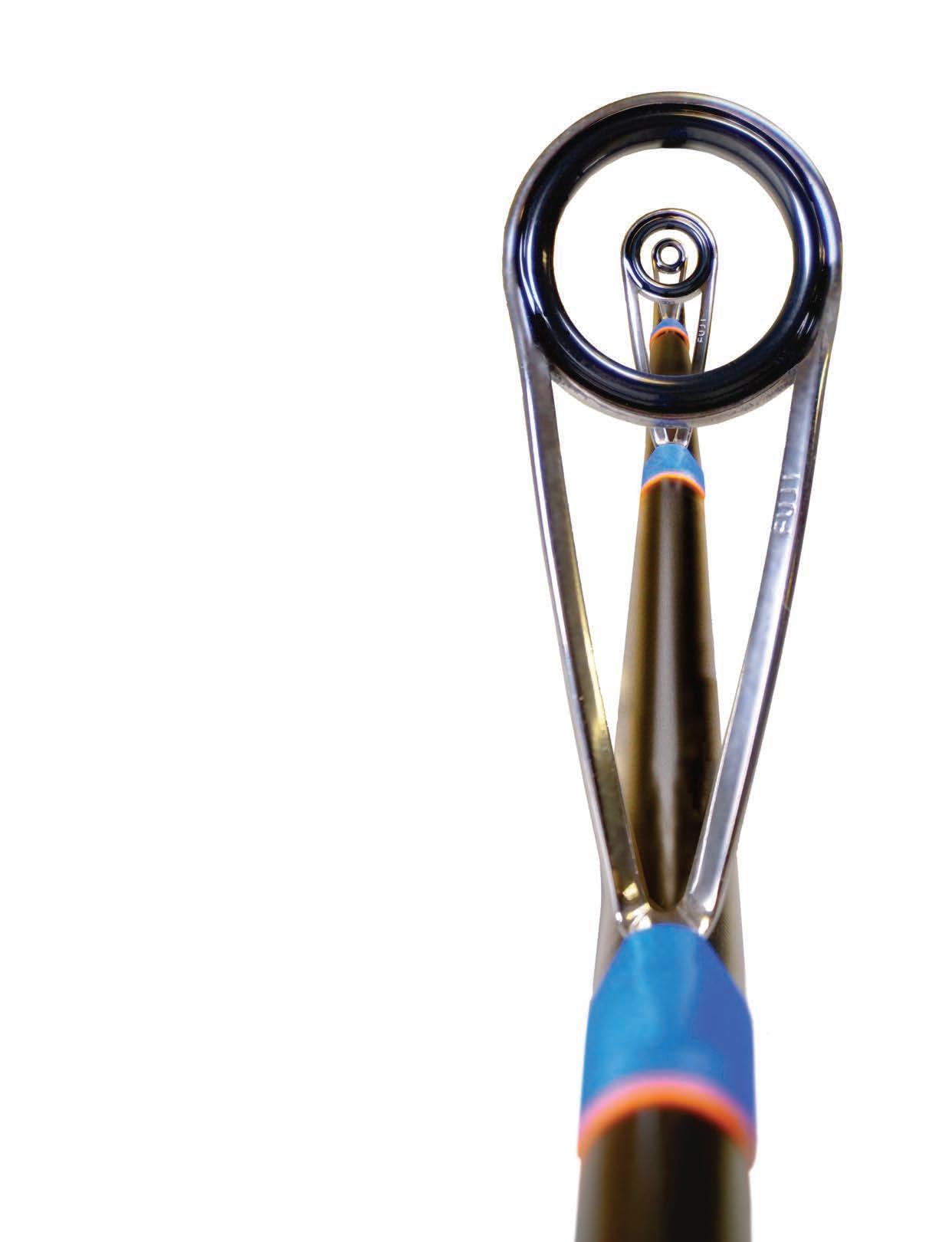
Take the KR Concept for example. It required Fuji engineers to step forward in a world full of size 30mm and 40mm reducer guides and demonstrate how a size 20mm, or even a 16mm, could do a better job.
Choose Fuji as your “go-to” components. You’ll get rocksolid durability, with the guts and brains to keep you ahead of the competition.
KR Concept’s high-frame, small-ring design has revolutionized spinning rod construction worldwide.
www.fujitackleusa.com

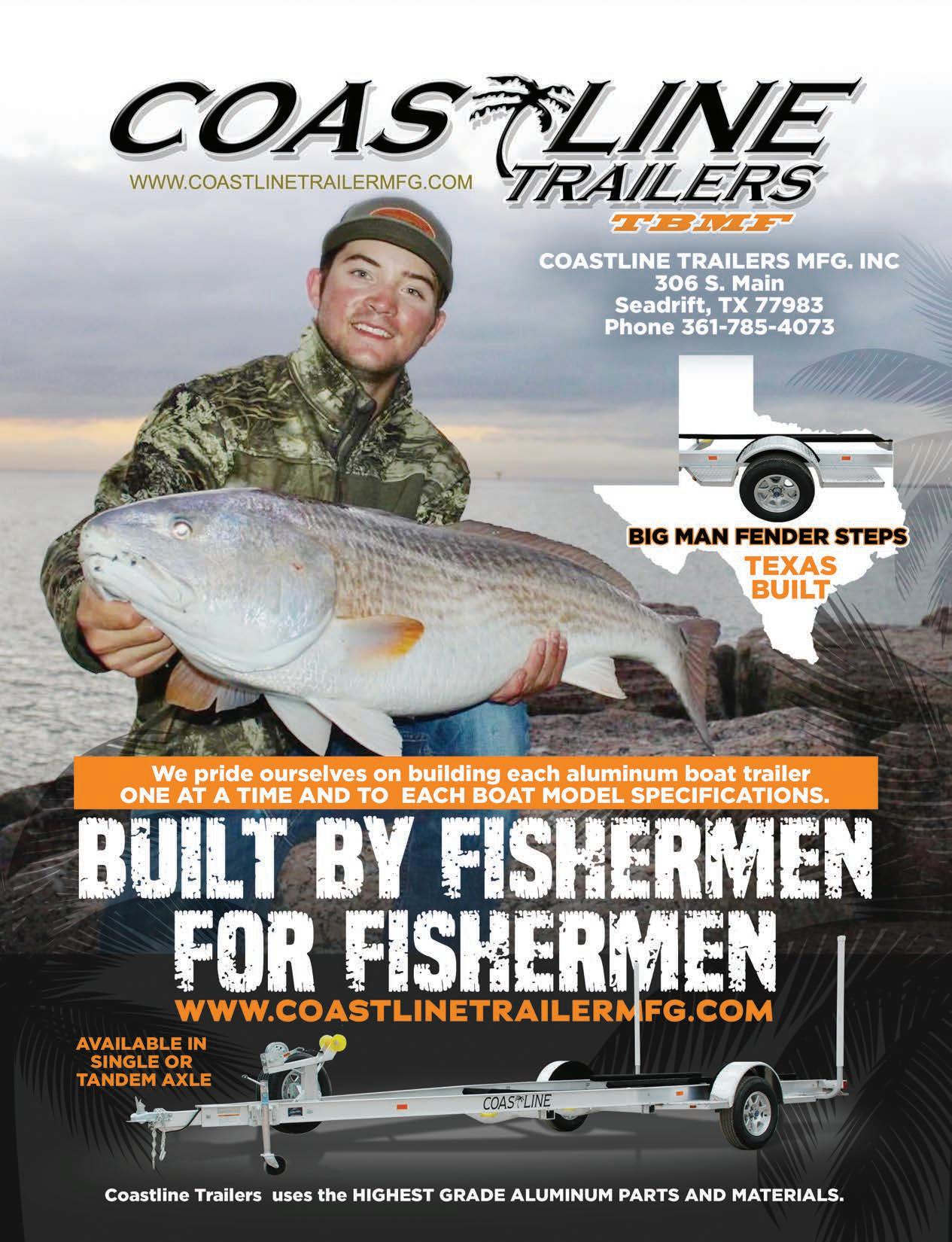
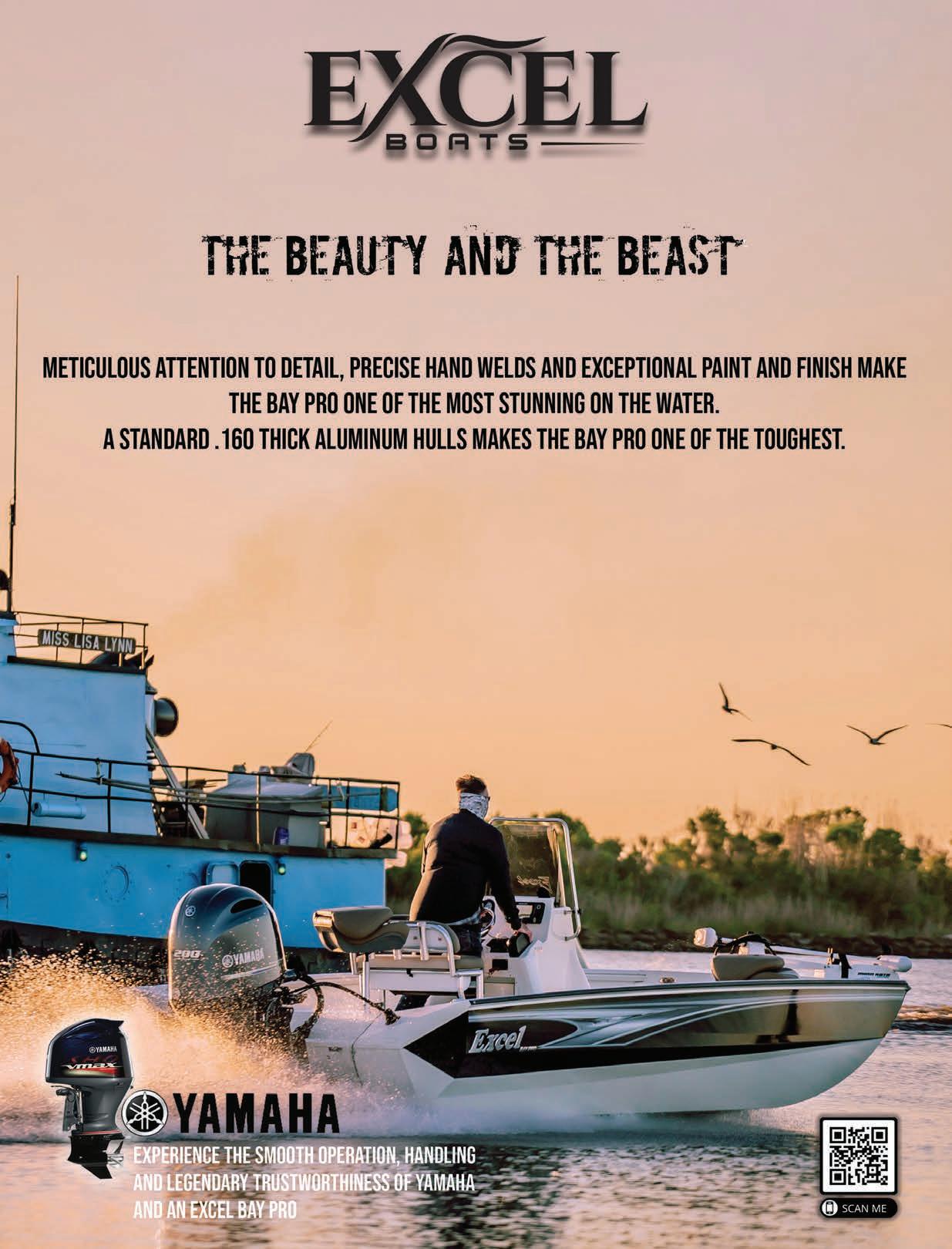
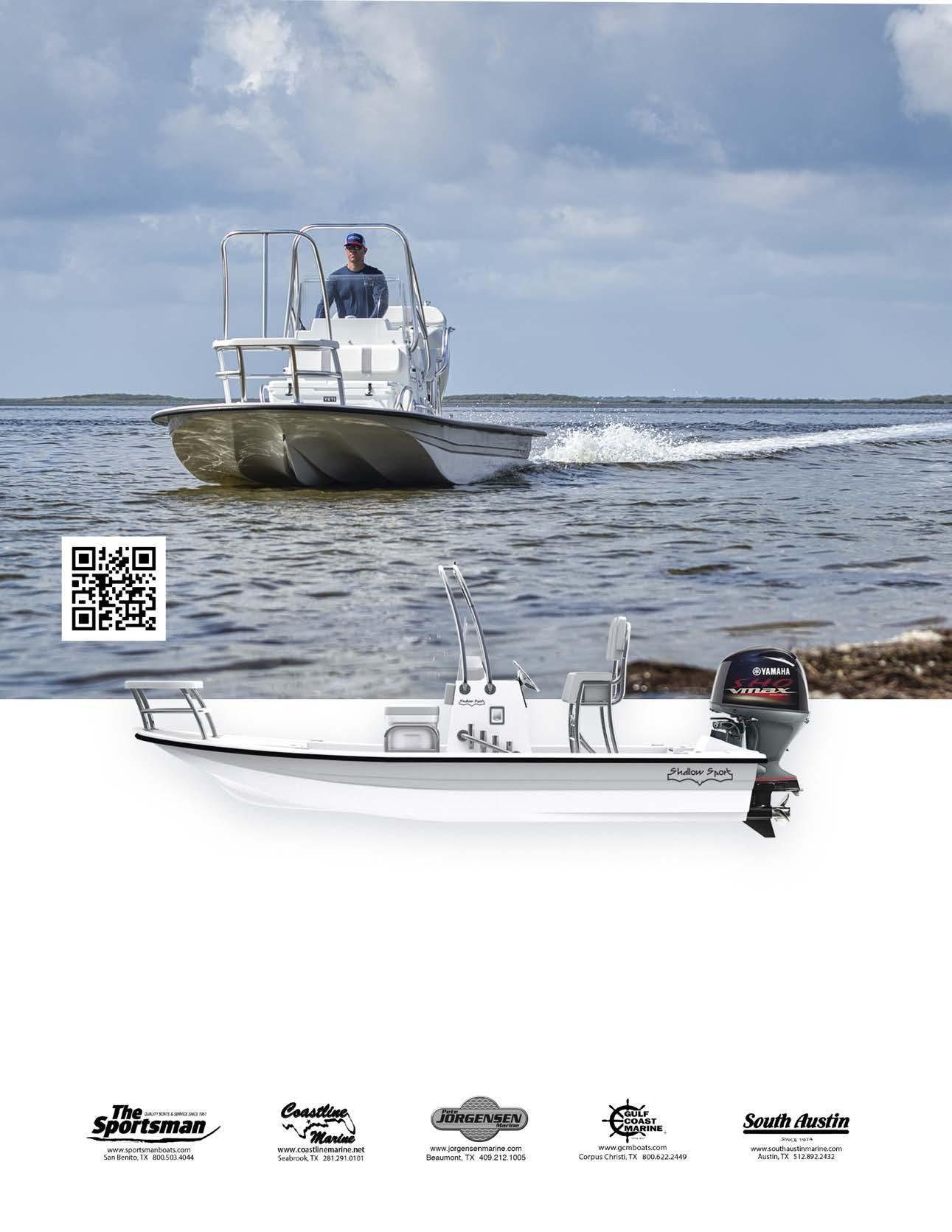

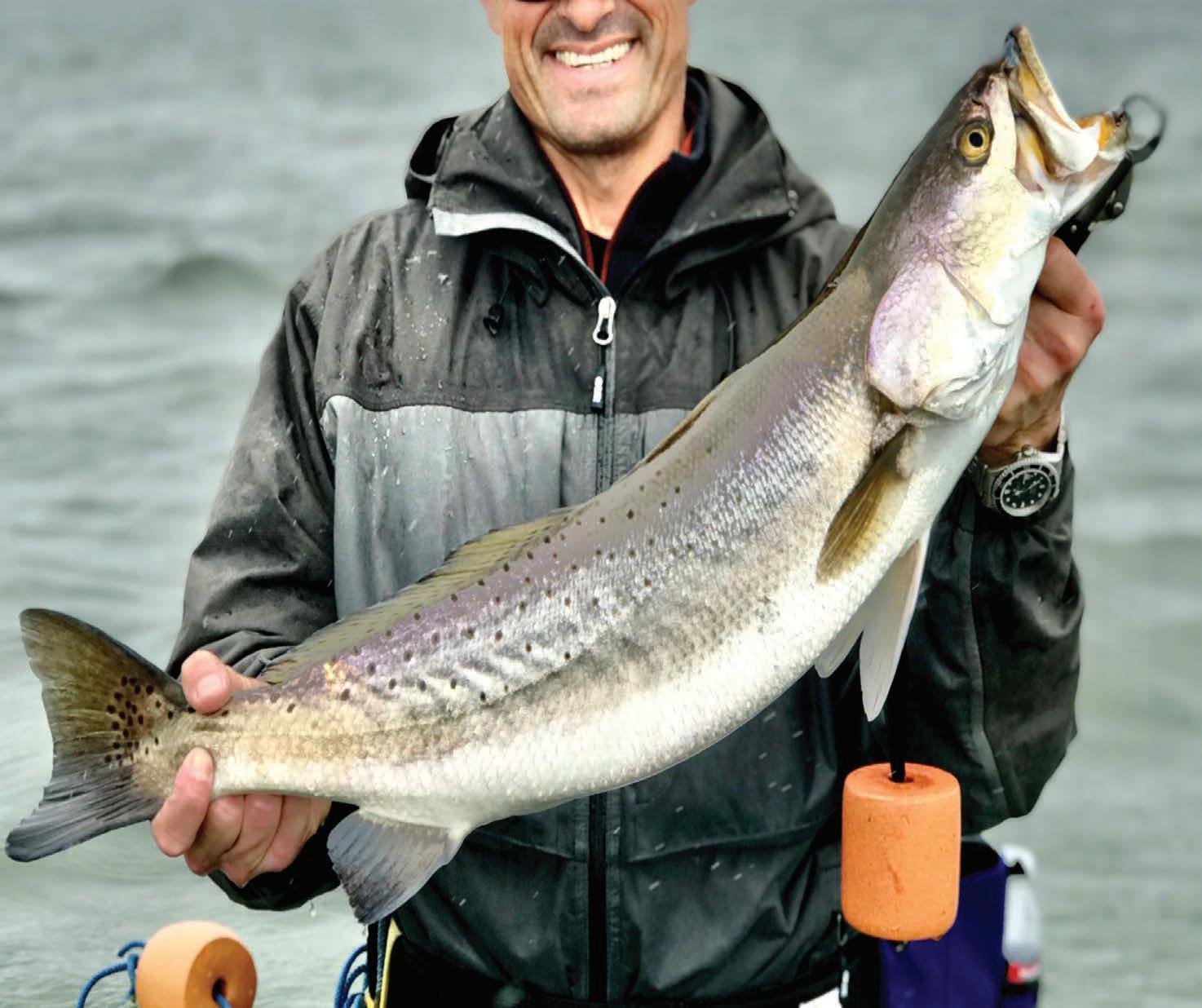

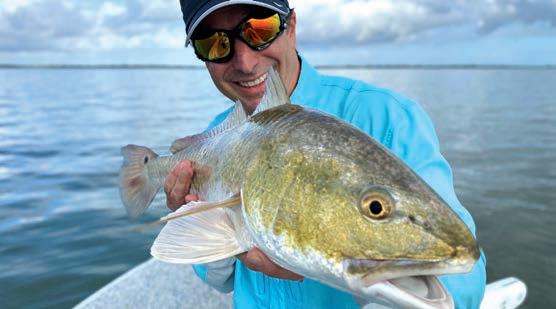
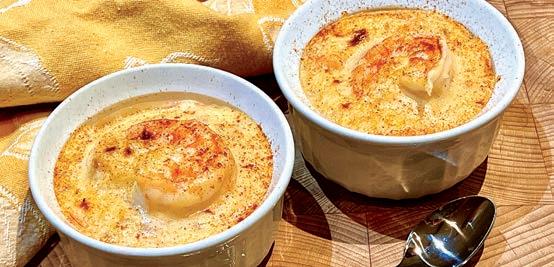
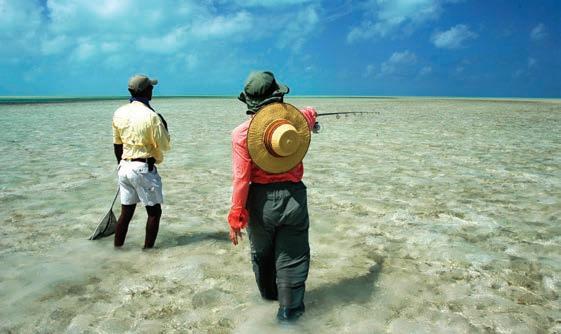





































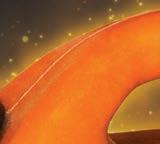
































View The Video Open Camera & hover over QR Code. When link appears, tap to open in YouTube.

January Issue Highlights
Happy New Year and welcome to 2023!

Highlights of the fall and early winter months include the Thanksgiving and Christmas holidays, mixed with a full range of hunting and fishing opportunities. It’s without a doubt the busiest season of the year for Texas outdoors enthusiasts. While I’m personally always anxious to see it come, I can honestly say I am almost equally anxious for it end. Now we can get down to some serious fishing!
Getting on the water during January has its challenges, at least from a weather viewpoint, but that’s actually part of the allure. Hardcore anglers don’t even give cold weather and misting rain a second thought. The reward for bundling in layers easily outweighs all of them – even the numb fingers. Just ask Capt. David Rowsey and this month’s cover angler, Chris Gwyn. These guys are by no means fairweather fisherman.

And there’ll also be some very pleasant days. I can recall lots of shirtsleeve afternoons in January, the kind that come a couple of days after a wicked front blows through. Fish don’t have to eat every day, especially during a bitter blast followed by
a sky-high barometer. But you sure don’t want to miss the day the barometer relaxes and the tide comes rolling back in. The words epic and legendary often appear in January fishing reports.

Common sense is the foundation for fishing success in any of the winter months. The biggest mistake any anxious angler could ever make would be failing to reference coastal weather forecasts. Next would be failing to heed warnings of impending dangerous weather. Speaking from experience, the last place you want to be is along the south shoreline of a major bay when a strong frontal system comes crashing to the coast. The last few hours of calm weather prior to the arrival are known to provide an incredible bite…but making your way back across the bay in towering waves can be dangerous, even life threatening. Don’t wait for the north wind to tell you when to leave. I have; and it was scary. And the scariest wasn’t even in winter, but the month of May, believe it or not. I scoffed at the forecast of 60 mph north wind. Boy, was that a mistake. Our only common sense that day was waiting four hours in Pringle Lake for the worst of it to pass.
So, with these words to the wise, my best advice is to pick your days and times carefully. There’s lots of great fishing opportunity coming in January. Check your waders in a swimming pool before heading out, dress appropriately, and pack some spare warm duds in a dry bag. The fish are waiting for you!
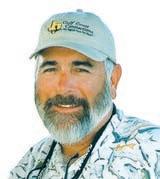

Activities such as ship channel dredging are a necessity but it’s difficult to quantify the damage caused by siltation of area oyster reefs.

For many years my January article has been a detailed monthby-month review of the previous year’s fishing along with some general observations and opinions. Rather than break down 2022 on a monthly basis this go-round, I’ve chosen to summarize what our experiences here in the Galveston Bay Complex were for the top three targeted species over the entire 12 month period.

Higher bay-wide salinities for the first time in several years resulted in fish being more evenly spread across the whole bay system. This meant that concentrations of trout could be found in fewer places, and almost always in proximity to some type of live habitat, such as oyster reefs. Finding those patches of fish hasn’t been especially difficult, but when you do it’s best to keep it quiet and don’t spend a lot of time soremouthing them. We carefully choose our times to move in and fish these areas and, even then, we’re constantly looking over our shoulder for other boats, praying that no one takes notice while we’re there. Employing this strategy has resulted in lower daily numbers than in years past. Please note that when I say “numbers” I’m not referring to boxing trout but simply catching them. Back in the day it was nothing to catch 75-150 legal trout per trip because we had so many of them in so many different areas and there were plenty to go around. Nowadays, we tend to catch enough to make everyone happy and then move on to target redfish in an effort to ease the pressure on those trout schools. In addition, we’ve mentally lowered the bar when it comes to having a “good” day.
Overall trout sizes for the year were smaller, probably 14- to 18-inches on average, with the exception of an occasional 20 or 22-incher, and a few rarely caught 25 to 28-inch unicorns. There is a dire need to re-establish a base speckled trout population of resident fish and then manage it properly. This includes
aggressive habitat restoration projects. Until this happens I do not believe we will ever again experience greater numbers of larger trout.
While there are ongoing oyster reef and shoreline protection and restoration projects it hasn’t been enough to get us anywhere close to pre-Hurricane Ike levels. While still helpful, small-scale projects alone aren’t going to be enough – not in our lifetimes, anyway. It will take huge, thousand acre mid-bay and shoreline habitat restoration efforts involving all stakeholders to begin to see a significant improvement in our fishery. This is especially true during a time in which we are dealing with ongoing ship channel dredging activities that carry silt for miles, covering live reefs in the process, not to mention the huge tanker and container ship wakes that further accelerate the erosion of reefs and shorelines. We obviously have to have commerce but the price for progress sure seems higher than ever these days.

It’s been three and a half years (September 1, 2019) since trout limits were reduced from 10/day to 5/day here on the Upper Texas Coast; (FM457 at Sargent and northeast to the Louisiana border). It was a move that I supported very strongly and one that I believed would make a difference. I want to believe that it did, but it reminds me of the ongoing highway construction projects in and around the Greater Houston area. It’s a continuous effort but it never seems to catch up with the population growth. The overall effort by anglers is growing at a faster pace than what our current trout fishery can sustain. Limit changes alone are just one piece of the puzzle.

For years, up until the Harvey floods that occurred in late August 2017, we caught many trout on a daily basis in the 3- to 4-pound range while 5- and 6-pounders were fairly common. Since then, we’ve been in rebuilding mode. The majority of trout we caught in 2022 were in the 1- to 4-year age class. A strong case can be made that we basically started over after those Harvey floods purged pretty much the entire Galveston Bay Complex of salt water (and trout) during that time creating a ground zero scenario.
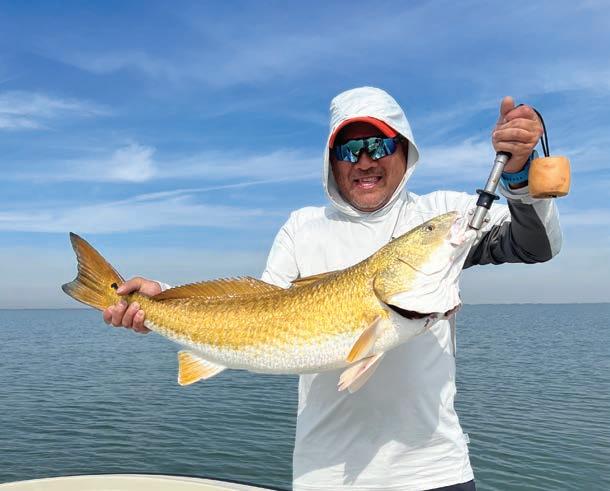
As has been the case for several years now, finding good schools of slot reds hasn’t been easy for us, other than when birds are working in the fall and winter months. However, schools of oversized reds seem to be uncommonly abundant in just about every part of the Galveston Bay Complex. I can’t exactly put my finger on the reasons for the shift from slots to giants in recent years but I would love to know the answers. I’m not saying that we don’t catch slot reds anymore, but just that the numbers of them are not what they used to be. Aside from chasing birds, most of the 20-28 inch redfish we caught in 2022 were in coves and along shorelines lined with shell. The back lake schools we used to rely upon are definitely not as plentiful. Mud boils and slicks were the best signs we used to target slot reds while slicks, terns, and large areas of muddy water pointed us toward the oversized reds along the ship channel and in the open bays.
While I seldom target flounder specifically we do catch our fair share. As a matter of fact we likely landed more flounder on my
Andrew Shaffer fights a behemoth black drum in the midst of catching dozens of trout. This was a common occurrence throughout the year. We have to find a way to increase efforts to offset the negative impacts created by channel dredging.boat in 2022 than I can ever remember. I’m inclined to believe that the amount of time we spent fishing with soft plastics along shorelines and near bayou drains greatly increased our chances for the uptick in numbers of flatfish. The majority were caught on MirrOlure Lil Johns and Bass Assassin 4-inch Sea Shads, but we did land quite a few on MirrOlure Corkys while wading during the colder months. Our most productive months were November and December for not only numbers but also size.
For the majority of 2022, lower than normal rainfall, record high temperatures, and persistently high winds resulted in much of our bays hitting salinity levels that more closely resembled those of Gulf water (~ 36 ppt). Extremely high salinities such as these are harmful to oyster reefs as high-salinity thriving parasites such as Dermocystidium can kill large areas of reefs. We need adequate rainfall to maintain the health of our bays from the smallest marine organisms all the way to the top of the pyramid.

Looking forward to 2023, I honestly feel like our overall fishing patterns for all species will mirror that of 2022, barring any significant changes. For what it’s worth NOAA’s U.S. Winter Outlook (released October 20, 2022) by the Climate Prediction Center (division of the National Weather Service) forecasts a third consecutive La Niña
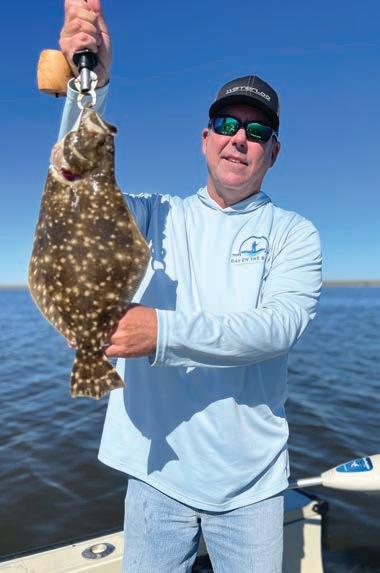
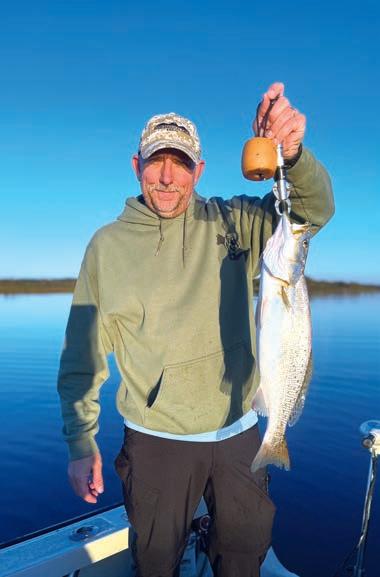
pattern, which predicts warmer than average temperatures for the Southwest and along the Gulf Coast and eastern seaboard. The prediction also calls for drier than average conditions across the South starting in December 2022 (noaa.gov). As I type this (November 28, 2022) we’ve had two recent strong cold fronts that brought 6 to 8 inches of rainfall in the past six days and air temperatures in the low40s, so the jury is still out on La Niña, in my opinion.
The overall health and productivity of our fishery is controlled largely by environmental factors. However, it is also greatly impacted by human activities. When environmental factors have negatively impacted a fishery as is the case of Galveston Bay, then all human activities are placed under the microscope from that point moving forward, and justifiably so. We need to be smart enough to believe what we see with our own eyes and then make honest assessments and react accordingly. We cannot continue to lower the bar and pretend that mediocrity is awesome. We need to collectively make a commitment to excellence. If nothing else, for our grandkids’ benefit.

Phone 4 09-256-7937
Email captsteve@hillmanguideservice.com Web w ww.hillmanguideservice.com

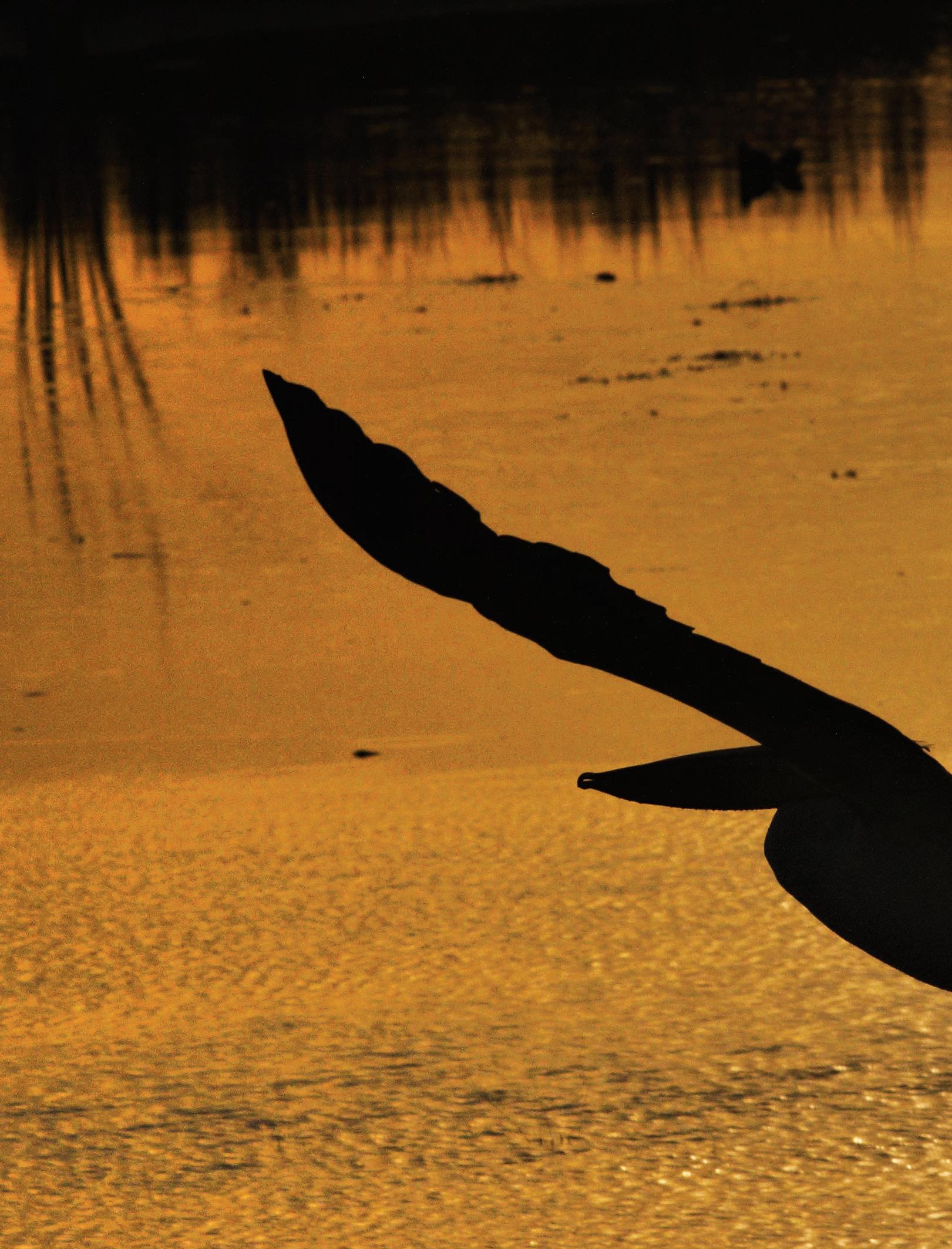
When signs of life indicating the presence of fish fall to zero, savvy anglers recognize the need to grind for bites in relatively small spaces. They often choose to fish microspots with excellent longterm records of production. When fishing these small-scale spots, planting the feet and repeatedly casting at and around some specific feature usually provides the best results. In essence, this works because making lots of casts in a known productive place increases the chances of presenting lures close to the faces of inactive fish.
Signs of life dwindle partly because inactive fish don’t aggressively chase after their prey. Fish unwilling to chase prey certainly won’t readily attack lures, so catching them requires provoking reaction strikes. Generally, soft plastics work best to urge disinterested fish to take a bite. Slow-sinking twitchbaits work well less often, and topwaters usually prove nearly useless in such situations.
As a trophy trout guide who has spent many days on the water in the colder half of the year, I’ve found myself dealing with a dearth of signs many times. On one well-documented occasion, we left the dock in darkness and began fishing under a bright moon. On the back side of a cold front, water temperatures had plummeted into the high 50s, after rising above 70 before the front hit.

Soon after we started fishing, I could tell we’d probably have a tough time getting bites. Bright moonlight glinting off the waves provided plenty of light, but we neither saw nor heard any signs of life, and Fat Boys and topwaters failed to produce strikes like they had on multiple outings made in the days prior to this one. Eventually, one of my customers caught a six-pound trout on a soft plastic, verifying what I hoped – some of the big trout I’d been catching on this shoreline remained present, though no jumping mullet, swirls or wakes provided evidence of the fact.
The excruciatingly slow bite perked up a smidgen as the moon settled closer to the horizon and the sun began to rise behind us, so I committed to fishing the place until after the moon had set and the sun rose higher in the sky. We made all our casts at potholes lying close to grass mats on the bank, managing to catch three more trout, all but one of which measured more than 22 inches. Eventually, I decided to move to a nearby location, one with nearly identical features and a recent record of productivity, where we scratched out two more trout, both of which measured about 23 inches.
A thick cloud bank rolled in about then, and we all committed to throwing soft plastics exclusively. I wound up making three more moves to stretches of the shoreline where I’d experienced recent success, fishing small-scale spots with bare, sandy patches on the bottom, lying close to thick grass mats. Significantly, the gray canopy facilitated our attempts to coax strikes in the shallow, clear water. On a sunny day, none of this would likely have worked. In total, we wound up catching twelve trout between 22 and 29 inches, and we shook off four other big ones after hooking them.
The catch was not a ten out of ten for March, to be sure, but it provided a satisfying outcome for a day on which I never saw a single mullet jump. When no visible signs of life indicate the locations of active trout, fishing small, proven spots with a patient and persistent mindset makes good sense. The previous statement probably rings most true in the first month of the calendar year.
In the Lone Star State, the average temperatures in January historically run colder than in all other months. Typically, the mercury rides low in the glass when signs of life reduce to nil in the New Year’s month. Dealing with the dearth in really cold water presents a stout challenge to any angler hoping to catch trout on artificial lures. Relying on several related strategies can help one turn a potentially dead day into a lively one.
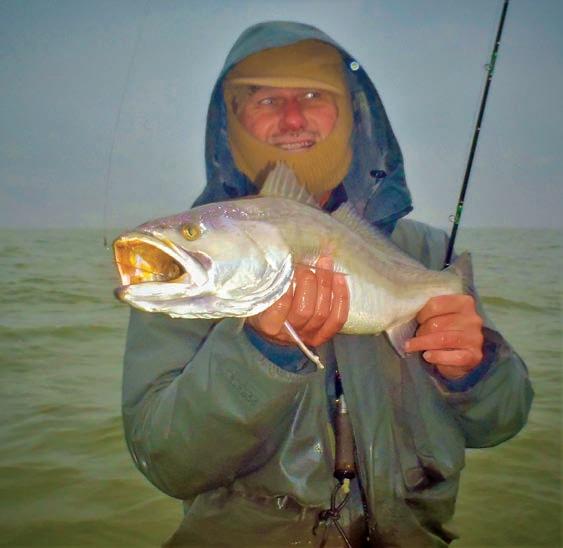

When fishing on a January day when signs of life like swirls, wakes, mud stirs, jumping mullet and slicks become nearly or entirely impossible to find, anglers possessing the most detailed knowledge of the layout of areas with relatively deep water where fish ride out cold snaps stand the best chance for success. The most productive small-scale spots in a situation with scant signs of life in cold weather lie in close proximity to basins, channels and holes where fish sit on the bottom while water temperatures decline after the passage of fronts. In a place like Baffin Bay, many of these areas include sand bars and related rock formations lying tight to the north shoreline.
In other bays, places close to north shorelines, which offer protection against the chilling effects of brisk winter winds, offer excellent potential when the bite gets tough in the heart of winter. Areas like Live Oak Bay in East Matagorda, the North Ridge in Trinity Bay, flats around Stewt’s and Sydney islands in Sabine Lake, and Gladys Hole in the Lower Laguna Madre jump instantly to mind. In all these places, structural elements covered by shallow water lie close to deeper water which stays slightly warmer than the water farther away
The captain’s old Troutmasters partner Ari Schwartz with a long trout caught on a soft plastic dragged slowly along the bottom on a cold winter day.from the buffering effects of the shorelines.
This truth helps one identify general areas to try, but success in the most negative situations relies on more detailed knowledge of sweet spots within these areas. In a bay like Baffin, such spots include specific clusters of rocks with bare, sandy bottom lying close to them, silty potholes on flats, close to drop-offs into the basin, and grassbeds growing on the outer edges of shallow flats. In other bays, where oyster reefs replace serpulid rocks as the primary structural elements, the sweet spots often lie adjacent to shell ridges, in places with silty mud on the bottom, where inactive fish sit on the bottom when not feeding.
Other factors come into play for anglers hoping to identify specific small spaces in which to stand and grind for bites in such negative situations. One of those factors relates to the water clarity. Generally, the water in Texas’ bays runs more clear in winter than in other seasons, since some of the life forms creating murky conditions diminish or disappear at low temperatures. Certainly, a consistently productive grinding spot would include water clear enough to allow anglers to see any of the primary structure and cover elements present, to facilitate precise casting. Casts presenting lures along edges and seams work better in general than casts made more randomly, for two related reasons.
First, casts made around the edges of structure and cover elements more often place lures within close proximity of targeted fish. Second, casts made at visible objects in the water provide anglers more hope for a positive outcome; consequently, anglers who can see the structures and cover elements within reach have more patience and persistence. Making dozens or hundreds of casts into water murky enough to prevent seeing any of the layout of the bottom requires a brand of mental toughness most anglers don’t possess.
And, water clear enough to allow anglers to see the layout of the place also facilitates the ability of fish to see the lures anglers present to them. These facts provide positive potential, to a point. Certainly, in ultra-clear water, anglers can probe parts of a place precisely and more quickly predict its potential for productivity. But earning reaction strikes in stupid clear water often proves more difficult than earning them in water with decent, though not ridiculously high, levels of clarity. In general, water with low to medium levels of turbidity provides the best chances for turning a tough bite into something more tender. Brighter skies elevate the potential for catching in places with higher turbidity levels, on average.
Once anglers find a microspot known or suspected to offer high potential in January, the focus of the quest shifts to the physical execution of a strategy. In most cases, the best strategy starts with the deployment of a soft plastic lure, either a paddletail or a rattail, rigged on a light jighead, either eighth or sixteenth-ounce. In clear water, the erratic movement patterns of a rattail make more sense, while the straight-line movements and vibrations created by paddletails produce better results in murkier water. Colder water, below about 53°, generally elevates the potential utility of the lighter jigheads.
Using a light jighead to present a soft plastic on or near the bottom requires the angler to exercise patience during the retrieve, allowing
the lure to sink after it lands, then using subtle movements of the rod tip and turning the reel handle slowly. In water of marginal clarity, the best plan involves dragging a paddletail slowly along the bottom, hopping it up slightly with gentle twitches, every few feet or so. In clear water, working a rattail close to the bottom, occasionally making contact with the sand or mud, while hopping it around slightly more forcefully makes better sense.
In limited cases, working a slow-sinking twitchbait low and slow, basically reeling it straight in and occasionally causing its head to gently wobble from side to side works well in this situation, especially when the angler has caught lots of fish on these types of lures on recent occasions, or on the same day, before signs of life dissipated. Any angler committing to use a twitchbait instead of a soft plastic in a super negative situation during January should do so with a legitimately high level of confidence. Experimenting with lures (and colors) in such a scenario usually results in diminished chances for success.
Certainly, anglers should methodically experiment with subtle variations in retrieve style while thoroughly probing sweet spots. This experimentation in a place known for its potential to hold fish accomplishes the most important goal of the strategy, allowing the angler to determine which specific type of presentation provides the potential to earn strikes from inactive fish. In contrast, wandering around over long distances and changing lures regularly when dealing with the dearth of signs usually invites a skunk along for the walk.
Kevin Cochran is a long-time fishing guide at Corpus Christi (Padre Island), TX. Kevin is a speckled trout fanatic and has created several books and dvds on the subject.
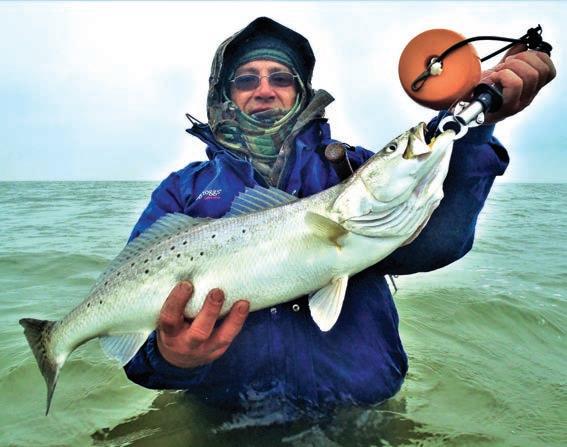

Kevin’s home waters stretch from Corpus Christi Bay to the Land Cut.
Phone 361-688-3714
kevincochran404@yahoo.com
www.captainkevblogs.com

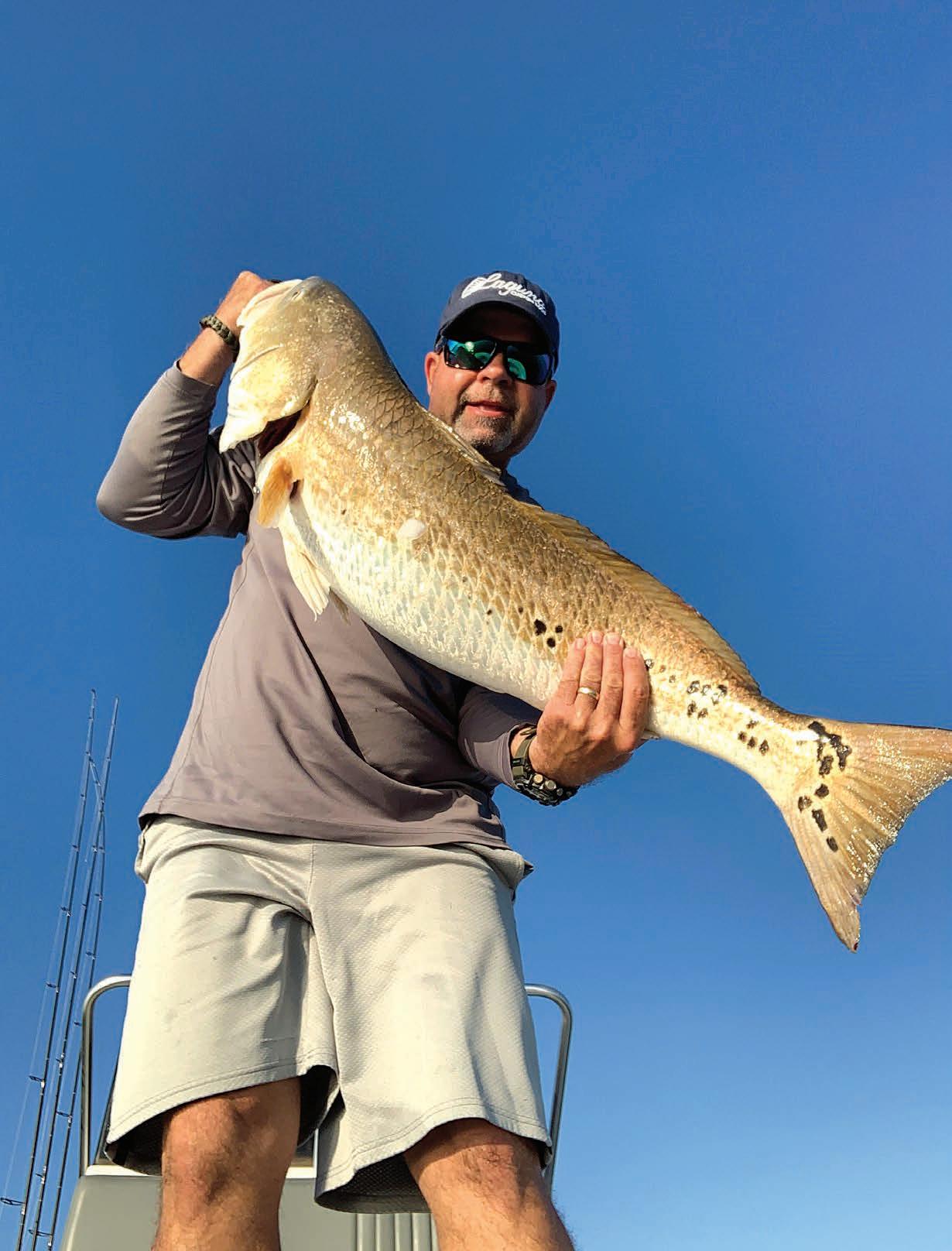 Another 40-inch redfish taken in the middle of schooling trout.
Another 40-inch redfish taken in the middle of schooling trout.
It’s no secret that everybody loves an underdog, everybody loves to see the comeback story with the fairy tale ending. I can honestly say that it’s been both painful and exciting to have ridden the rollercoaster we call Sabine Lake for the past 5-plus years; and at the moment it appears that things more closely resemble normal than they have in quite some time. Like a punch drunk prizefighter, our little mud-hole of an estuary on the upper coast has managed to get up off the canvas after suffering several heavy blows that seemed certain to knock it out for good. Our “liquid Rocky” has shaken off the effects of floods and freezes only to start returning to form once again. Now don’t get me wrong, Sabine has a long way to go to get back to the gem she once was, but she is certainly headed in the right direction.
In the mid-to-late 90s Sabine Lake went through a type of renaissance, an enlightenment if you will. The lower coast had long been the Mecca for big trout and eventually both anglers and techniques from that part of the state made their way to Sabine and that really was the start of her glory days. The late 90s and early 2000s were insanely good fishing for trophy trout on Sabine, in fact the lake record of 11 pounds and 12 ounces was caught by Dr. Kelly Rising in March of 1999. Nobody had ever heard of a double-digit trout coming from Sabine and it was widely acknowledged that if you wanted a fish of that caliber you needed to go south towards Baffin or the Laguna Madre until everything finally fell into place. Wade fishing for trophy trout became a common technique and the next thing we knew was that there were some really big fish being caught nearly every day.
The big trout epidemic did nothing but get better as the trend crossed the border into Louisiana, and just kept getting better. The mid 2000s on Calcasieu were epic, almost ridiculous. I know I have told many people on lots of occasions that during that time if you went to Calcasieu and did not catch a 6-pound trout it was a bad trip, and I still stand by that statement. Both Sabine and Calcasieu were not only spitting out trophy fish they were incredibly good for overall quality fish. For many years we enjoyed catching 18- to 22-inch trout under birds with an occasional school from time to time that was full of nothing but 3- to 4-pounders. I actually had two clients catch 8-pounders while fishing under the birds on Calcasieu. It was that wild.
Fast forward ten years or so and the entire program was flipped on its head as several hurricanes produced massive flooding. Toledo Bend consistently had historic high water levels that provided unprecedented runoff, and a couple of very bad freezes spelled nothing but trouble for our area. The last big punch to the gut was a flood during a freeze. Talk about taking it on the chin!
The most widely accepted theory was that most of the fish in the estuary had moved to deep water to escape the cold temps and were basically washed out of the area by the flooding. It wasn’t long after that chain of events that you couldn’t buy a trout or redfish anywhere; it was like nothing anyone had ever seen. Sabine seemed like a wasteland and Calcasieu was not much better. If you go and check some of the historical tournament results from the last five years the winning weights would blow you away compared to other years. To say things were dismal would be a huge understatement.
As trout fishermen were in denial, a bright spot appeared two years ago as it seemed the redfish population took off overnight; they just somehow appeared and saved the day for many anglers. Not long after that was a glimmer of hope, starting on Calcasieu, as herds of undersized trout invaded the lake. At times you may actually have to catch a hundred or more fish to find five keepers. Even though all those fish were small they

were very healthy and that was a cause for optimism. Soon after the resurgence on Calcasieu those very same small trout began to show up much more frequently on Sabine, and we quietly held our breath, prayed that it was a sign of things to come.
2022 has been the best year we have had since Hurricane Harvey hit in 2017, and that’s not really saying a lot compared to ten years or so ago. Sabine still has a lot of catching up to do in order to reach a more “normal” state that we are accustomed to. Trust me, I am not complaining at all and will take anything at this point that appears
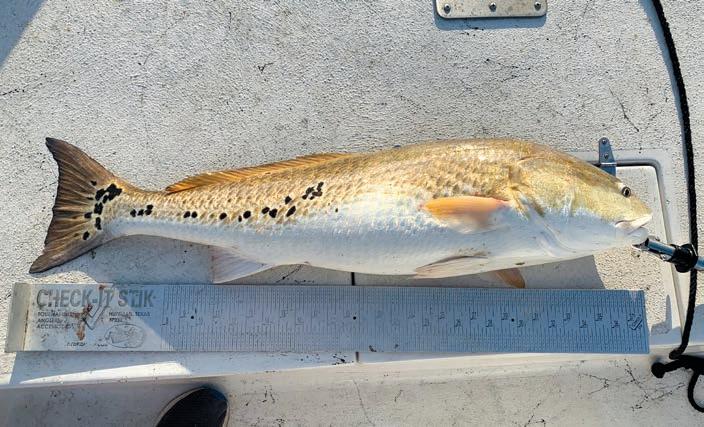
to be progress. The last few months have been much more like normal in the sense that we have been able to catch fish using patterns that we are accustomed to fishing at this time of the year. The schooling action has been very solid all over the lake but the majority of the fish are still on the short side. There have been some solid fish in these schools but the name of the game is going through numbers in order to find keeper-sized specimens.
Easily the biggest star of this past fall has been the emergence of some absolute stud redfish, the kind that test both your drag and stamina. I have caught more 40-inch redfish this fall than I have in the last five years combined. It’s amazing.

These big redfish are shadowing the schools of little specks and sand trout searching for a meal, and often finding one. On several occasions while reeling in a small trout that ate a soft plastic we have had redfish engulf the trout and head for Mexico until they spit it out. These big fish are prowling everywhere from under the birds to the deeper breaks in the channels – you just
View The Video Open Camera and hover over QR Code. When link appears at top of screen tap to open in YouTube.

Sabine Is Back…and the Fishing Is Great
never know where they will show up. I caught a 25-pound redfish recently that gave my Laguna spinning rod all it wanted, and then some. I was amazed at both how strong that fish was as well as how well that light action rod handled the fight.


Going forward I will be cautiously optimistic at what the future holds for us on both Sabine and Calcasieu. Hopefully we won’t endure another severe freeze and all those short trout will grow a couple of inches and we can stay on the road to recovery. I can honestly say right now I feel much better about the long term health of the lake compared to this time last year and that is all one can hope for.
I hope each and every one of you enjoyed a wonderful Christmas and an even better New Year.
Chuck fishes Sabine and Calcasieu Lakes from his home in Orange, TX. His specialties are light tackle and fly fishing for trout, reds, and flounder.
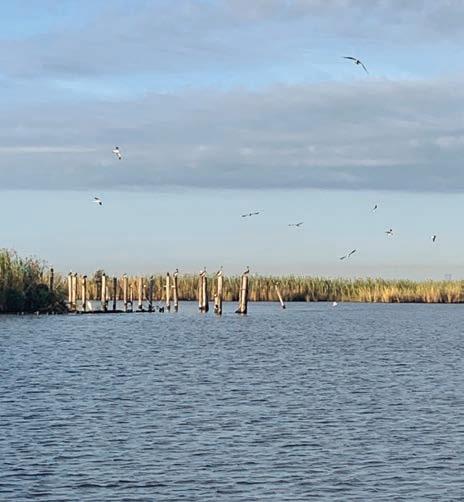

Phone 409-697-6111
Email wakesndrakes@yahoo.com Website wakesndrakes.com
When wading for bonefish, light line is required. Start off with 8-pound mono.

Ihave spools of fishing line everywhere these days, some “expired” and chalky looking, with others still fresh and slick. Several plastic boxes full. Different brands and line classes for all sorts of different jobs. It’s all monofilament, because I never could get into braid line, which is popular these days with inshore tournament guys; in their YouTube videos you can hear that distinctive Whew! Whew! when they crank their spinning reels with a fish on. After recently spooling up several reels, I thought I’d share what has worked for me over the past 50-plus years on the water.
Nowhere does the phrase “one size fits all” look worse, than with fishing line. It’s true that a range 12- to 20-pound line can accomplish a great deal in the right hands and in different venues, but it can’t do everything.
These days, my 4000 size spinning reels, so easy to cast even in wind, are used for catching all sorts of inshore species, and they’re a perfect match for 12-pound line. In my case that would be either Ande or (more easily found) Berkley Big Game. Both brands are what I consider to be “hard” lines, not so easily cut on structure, compared with softer brands. We’ve used Ande for about 40 years and that’s a tough line around jetty rocks and big barnacles growing on Gulf platforms offshore. They’re handy around oyster beds and limestone rocks in Baffin Bay, too.

Lately that 12-pound has worked and been sporty with bay redfish; I had a five-trip winning streak this past autumn, with my boat landing a combined 105 redfish, and we didn’t break off a single fish while using that 12-pound line. It should be noted that none were seven-pluspound (what I call tournament winning redfish). They were slot-size reds from 18 to 25 inches. Caught by making long casts in five feet of water, over clean bottom with an occasional small snag. In this scenario and others I still use more 12-pound line than any other class, trimming away frayed line after each trip and after a few months, re-spooling entirely. Recently I turned in a two-foot cloth bag full of used line, to a local tackle shop for recycling. Fresh spools of line are sealed in quart-size plastic bags, mostly at home but at least one in the boat in case someone is spooled by a shark, jack or big stingray. Hooked to a big fish, some clients don’t realize they’re down to a few feet of line until I hear a disturbing Pow! Which means no line. They didn’t realize they could have gripped the reel’s spool and broke the line way out at the leader. With a spare spool, I refill their empty reel quickly by placing the 1/4 pound spool of fresh line in a small bucket, where it can spin rapidly. A hundred yards of new line fills their reel in less than three minutes.
In our early decades of humping up and down the jetties for trout and mackerel, or working jigs deep around Gulf platforms, we used baitcaster Ambassadeur 5500 or 6500 reels, packed with 20-pound Ande. Tough line, that could cut a finger. There were countless days of slinging spoons from the rocks, or jigging around the platforms for all sorts of critters, from ling to snapper. Even from the stern of partyboats, though out there in blue water, we were undergunned with so many heavier lines in the water. Eventually we upgraded to 40-pound Ande on Ambassadeur 7000 reels, casting far from the boat with stiff 8-foot rods, and did so much better. Back on the jetties with 20-pound line, we caught loads of Spanish mackerel without using leaders, but also lost many gold spoons. Fortunately, they were cheap Acme spoons bought at Gibson’s. As for those many kingfish tourneys years ago, our fish were all caught using 40-pound Ande line. Twice, winning kingfish were caught after the fish ran around a corner of the Gulf platform we were tied to, the line scraping barnacles. We’d free-spool until the boat was hastily idled around the corner, and out into open water. We also had a second-place king wrap around our parachute cord buoy line out there, and the Ande cut the buoy line and the fish was landed. If we’d used a softer line, we would never have landed those kingfish, much less made the winner’s circle back at tourney headquarters.
Back inshore, our tarpon tackle had 40- and 50-pound mono on the reels. Hooking big tarpon on the Texas Gulf is a slug-fest because
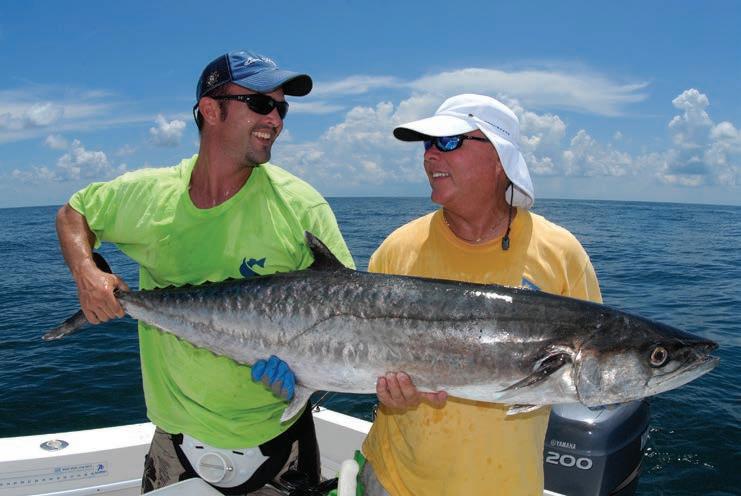

these fish can run deep and sulk, or they take to the air repeatedly, wearing themselves out. (Every tarpon is different.) Those big sluggers that go deep require hard work, like pulling on a shark. This is no place for lighter line, and our 40-pound was actually a little light. You don’t want to prolong the battle until that tarpon is almost dead. Aside from ethics, they are too few and precious to waste. Heavier line means a shorter battle and a better release. In that scenario, we consider 50-pound to be ideal.
Heavy mono leaders required for those long battles were made from spools of 150, 200 and 300-pound Ande. Many bull redfish were landed with those leaders. The same leaders were also used for deep-dropping with a window weight, some 700 to 900 feet down for grouper and tilefish. Fishing way out there in the Gulf you mostly see 80-pound line on the reels, either braid or mono used for marlin. When
A decent-sized crappie will tug and pull, but 6-pound line overall is still ideal here.bottom fishing in deep water, you want nostretch braid for detecting bites from deepwater grouper. Nine hundred feet down, mono line will work but it stretches like a rubber band and you can’t feel a bite.
At the opposite end of the line scale, I’m currently shopping for fresh 6-pound line for my ultra-light reels. Why? Spring crappie season is just around the corner and I need a spool of soft line, like the Mr. Crappie brand. Eight-pound line will do, but six-pound is better; you want that little jig to perform and light line draws more strikes.
Other considerations: While up in Canada, portaging the canoe to 19 different lakes, I loaded my only reel with 8-pound, which seemed a bit heavy. With eight, you can snag the shoreline and actually pull the canoe over there to jiggle the hooks loose. Some of those lakes were so clear (you could see 25 feet down) that the lake trout might have seen that line. (Friends in the second canoe used six-pound and caught more trout). Lakes up there vary but have no tree snags after being carved out of rock 10,000 years ago. We caught some big smallmouth bass off their nests using topwater plugs and those were energetic fish, so maybe eight-pound was better than six. There were no break-offs that trip, even from bigger pike.
Traveling anglers should carry a choice of lines, but keep in mind that eight-pound also works great in the southern latitudes for bonefish. They live in crystal water and have keen eyes, and it’s a serious mistake to lob 20-pound line out there across flooded, white sand flats. That’s a venue where you want lots of line, not strength. Hooking one of those fish is like being tied to a small rocket, or close to it, so its best to loosen the drag and let that hooked fish run out of steam on the horizon.
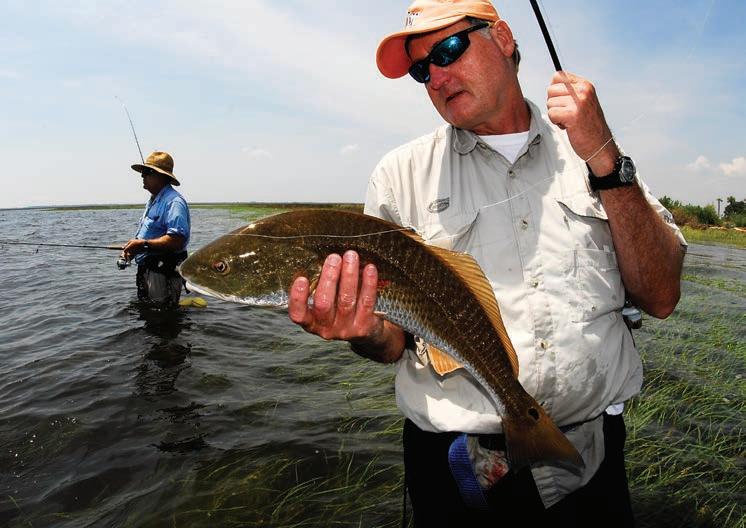
That’s why there are many proven sizes and several brands in my tackle room. They are there out of pure necessity, each with specific goals in mind. Bottom line, it’s good to think about such things ahead of time.
of Tide magazine for eight years, and later Florida Sportsman’s book and assistant magazine editor. He began guiding out of Port O’Connor in 1994. His specialty is big kingfish, and his latest book is The Kingfish Bible, New Revelations. Available at Seafavorites.com
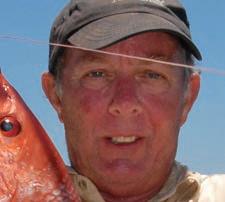
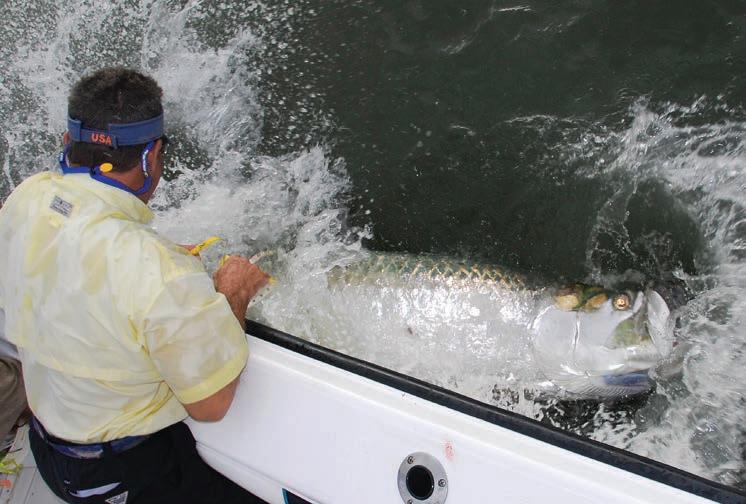
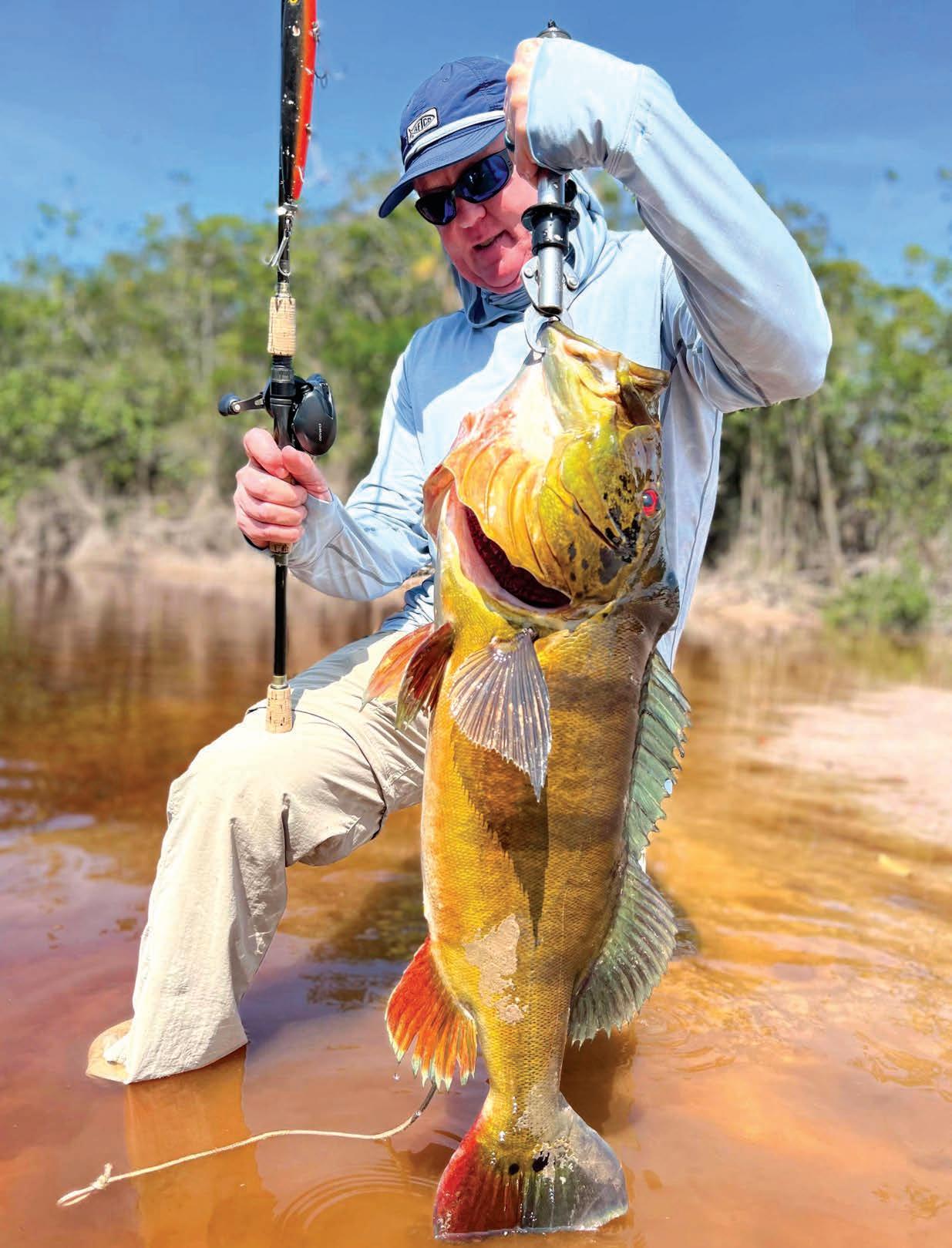
Anticipation was running high, expectations were hard to manage, the only thing that kept us in check was the daunting headwind of our itinerary. Thanks to lingering COVID travel restrictions we were facing a complicated schedule of flights through five international airports, but short layovers kept us motivated toward fulfilling our quest for a world-record peacock bass. Worthy of note to anyone hoping to make this trip; travel restrictions have been eased and itineraries are currently more traveler-friendly than when we booked our flights.
We arrived at the airport in Manaus, Brazil and were greeted by Eddie, who had a van ready to transport us to the TRYP hotel. We arrived at 3:30am. The lobby and bar were barren except for the bartender asleep on a chair in the corner of the room. Bobby Walker and I could not help ourselves and had to awaken him for our usual celebratory drink, (see QR code). Our bartender, sleepy-eyed but eager, mashed a pile of lime slices in a glass, added some sugar and then a healthy dose of Cachaca, a popular Brazilian rum. A few minutes later we had caipirinhas in hand, the national cocktail of Brazil. A quick toast and the best tasting drink I’d had in months filled my mouth with confirmation that we were where we needed to be. The celebration was short, simply because we had a floatplane waiting for us in four hours. We decided it was time to catch a nap.
We met the floatplane on the tarmac after a short five-minute drive from the hotel. My Simms waterproof bag containing just 25 pounds of essentials and a small backpack was all I needed for my three weeks stay in the Amazon. As we positioned for takeoff, I couldn’t help but notice a spattering of old, damaged airplanes along the airstrip (see QR code). Off we went, and as we flew high over the Amazon the clear conditions were ripe for the quest for trophy peacock bass. We could see white sandbars all along the Rio Curicuriari, which meant the water level was low. Just under four hours later we made a smooth water landing where our houseboat, staff and guides, would greet us. The accommodations were exceptional, that being a small room with a comfortable single bed, air conditioning, and a small bathroom. We had a nice clean dining area and covered upstairs deck on top of the houseboat overlooking the dark red water with forever views of the rainforest.
Within the hour Bobby and I were chunking the most popular peacock bass bait, woodchoppers, in backwater creeks deep in the Amazon. You just knew it would be moments before one of us would hook up. A short time later a 16-pounder came to hand on another traditional big fish bait – a brightly colored red and yellow jig (see QR code). Once back at the camp we had an excellent meal and was briefed by our host Harold about what we were to expect in the coming days. I can clearly recall him saying, “You won’t catch a lot of fish, but the ones you catch will be big.”




The next morning we were greeted with coffee thick and rich enough


to pass for motor oil. No complaints though, so long as you like your coffee strong. We had eggs, bacon, pastries, fruit and everything in between to choose from. We packed a lunch, met up with our guide, Eder, and off we went in our nicely equipped aluminum boat with comfortable bass boat seats.



Cruising the river banks provided the most incredible scenery. The rainforest is thick and lush and every so often we would spook a flock of macaws from atop tall palm trees. Most of the time you heard them before you saw them. They don’t seem to like being disturbed, and they sure let you know it. Not much wildlife other than a few otters and an occasional caiman alligator, but the

beauty of the landscape was mesmerizingly deep and rich.
Every spot we fished looked fishy, and every cast looked like it could and should yield the next world record peacock. Ninety-plus-percent of our casts came back empty but the remainder more than made up for it in a clear and obvious way. The explosions from peacock bass are real and vicious; words alone just cannot do it justice. Our Shimano Curado reels were spooled with 65-pound braid, with the drags cranked as tight as they could go, to stop the peacocks from tangling in the brush along the banks. Still, it was no match for big peacocks that easily stripped 40 feet or more line with ease. When you hookup you know you’ve got something that means business on the other end.
Bobby and I landed an average of about three fish per day, but many more misses and mess-ups. Some were clean misses and some left hefty treble hooks completely straightened. Nothing under 10 pounds came to hand while the biggest of the trip was a 24-pounder that taped 93 centimeters, landed by yours truly. This monster slammed a pearl colored KWigglers Long Tall Sally rigged on a 3/8-ounce jig head as I reeled it over a clear ledge and let it fade into the dark red water. All I can say is what a fish!
Being within miles of the equator we experienced extreme heat and a couple of intense storms, but nothing dampened our spirits or interfered with our quest. We pressed on every day despite bruised ribs and sore arms from lobbing woodchoppers and huge swimbaits at every opportunity. You never pause a bait; you always work it to its and your own fullest potential; peacock bass do not like anything slow.
One day we met with the chief from a local tribe who happened to be the President of the Federation of Tribes who manage and control

who comes in and out of the river. This is a federally-protected area and Acute Angling International has the sole outfitter relationship on the river, which lends to the extreme remote feeling it deserves. I was fortunate to have the chief and a couple of his men cook a jungle meal for me; whole piranha with banana for desert. The culture from this tribe is rich and their tradition is real. This was a true treat, and quite frankly the piranha was excellent, despite me wondering how long it might have lain in the sun before going on the makeshift grill. The organic hot spice made from peppers and other native rainforest vegetables had a kick, but the flavor was to die for.
We repeated days like this for just short of a week with similar experiences and results. There is not enough space here for me to provide details of all that I experienced and learned. But if you can imagine being deep in one of the remotest parts of the world, fishing for world-class peacock bass with absolutely no other people in sight, eating some of the best food you ever put into your mouth, then you are thinking about it accurately.
Our journey ended with Bobby and I taking the same floatplane out of the Amazon and back to Manaus, where we met up with some of our good friends, only to join on another Amazon adventure up the Rio Negro, on another houseboat with a different outfitter. This trip was also exceptional but I’ll leave that story for Pam Johnson to present in another issue.
My peacock bass adventures will continue in October of 2023 and 2024. Currently the 2023 trip is full, but we are looking for a few trophy peacock bass hunters for 2024. This is not a trip for just anyone, but if you are interested, and more importantly up for the challenge, reach out to me for more information.







Winter patterns are now in place due to recent consistency in frontal passages and colder water temperatures. The most recent front dropped air temperatures a full thirty degrees. With these developments I have turned to throwing more suspending types of lures throughout my day. I have always believed that the best anglers allow the fish to provide the information needed each day to allow us to catch them. I will continue to rely on soft plastics like the MirrOlure Lil John XL and Bass Assassins to do some work for me but for the most part I will be searching for situations that will allow me to throw Custom Corkys, Custom Corky Soft-Dines and, of course, the Texas Custom’s Double D Series of suspending, swimming and floating baits. These lure types not only allow me to keep the lure in the strike zone longer but they often provide a reaction strike from fish that are not in active feeding mode. Yes, they are predators, and sometimes attack solely for the sake of attacking.
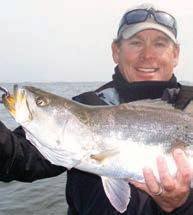
My personal view on the Corky bite during the winter months is the relative scarcity of 3- to 5-inch baitfish that trout prefer. Trout will definitely eat or attempt to eat very large mullet and even other trout when left with no other choice. Truth is that smaller baitfish provide for an easier meal to digest, which equates to less energy being expended. Conserving energy is extremely important
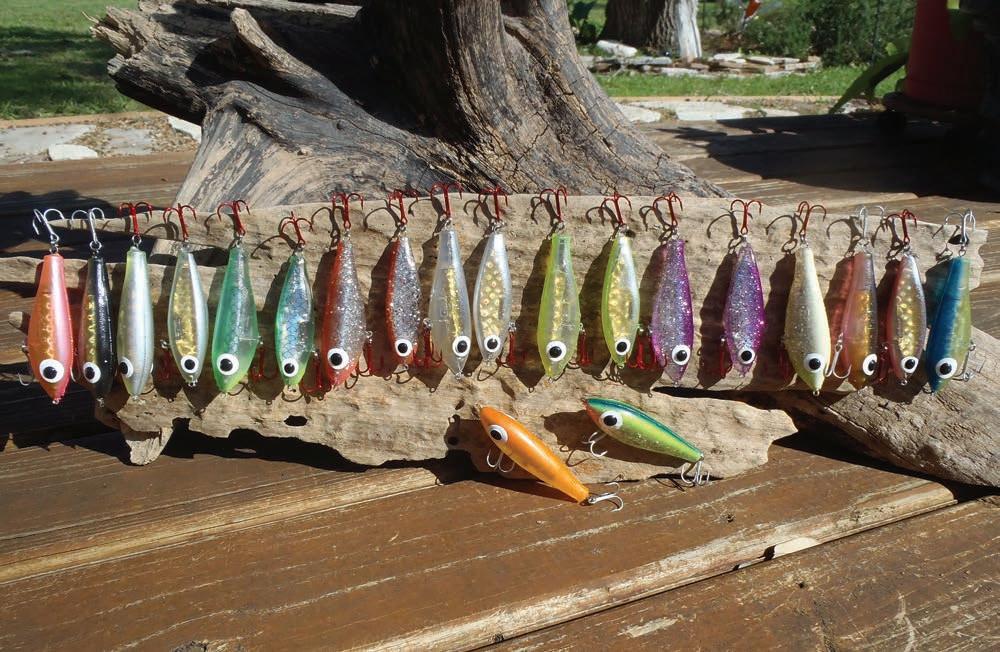
during the harsh winter months. I have seen many a big trout and redfish choked to death while trying to swallow a very large fish during the winter months. I am also not a believer that trout go to darker, muddy bottom in winter simply for warmth. I believe they follow the mullet, their primary food source to these areas of soft bottom because the food source for the mullet is more readily available in the mud. It is true that shallow, darker bottom will warm faster, but I am not of the belief that the trout seek out this type of bottom strictly for warmth.
This past week our water temperatures dipped to 46°, which led bay residents to stage deeper. For nearly six days we had zero in the warming department due to intermittent light rain and literally no sun to warm the waters during daylight hours. This often results in a shutdown in our production due to limited feeding periods and deeper feeding patterns. If you have met me you know I am short and it seems that age is shrinking me by the year. This forces me to fish shallower at times than I might truly need to be fishing. I know I could drift with the trolling motor and probably catch them but I am saving the drifting game for the gun lap stage of my career.
Our bay waters clear drastically when water temperatures are cold enough for long enough periods to reduce the suspended algae count, which can make for even tougher fishing days. An overcast sky helps
as the water begins to warm but this did not happen during the past week. I personally struggled for a three to four day stretch but finally began to catch a few more trout as water warmed to 50° and above. Reds were also tough but we were able to find a few here and there. All of the fish were super heavy for their length, which is quite common with winter-run fish.
When we found an osprey or brown pelican hitting the water, even only one, we caught fish. I did not see a single mullet jump, push, swirl or flip for three days. When the water bumped up to just over 52° we began seeing some limited mullet activity. Everywhere we found this activity we caught fish, and occasionally a really good fish. These are the situations where a Corky, Double D, MirrOdine, or Soft-Dine can greatly increase your odds of tricking some of the largest fish that might be in the mix with the large mullet.
The beauty of these lures is that they can be worked both fast and very slowly, depending on what the fish are showing us. No other lure in my opinion allows its sink or rise characteristics to become such an educational tool. Anglers that are savvy to sink rates and the timing per foot of descent are able to determine with considerable accuracy the depths in which the fish are staged at any particular time during the day or night. I don’t do night fishing anymore, never really cared all that much for it, which means I’m no expert in that department. I’ll leave that to guys like Mike McBride and John Gill, who in my book are far more versed in nighttime trout tactics.
On several occasions the past two weeks I have found great trout over shallow grass or scattered shell where a Custom Corky Fat Boy or Soft Dine was the absolute ticket to getting the big fish bite. The capabilities of the lure over the shallow structure were the total reason
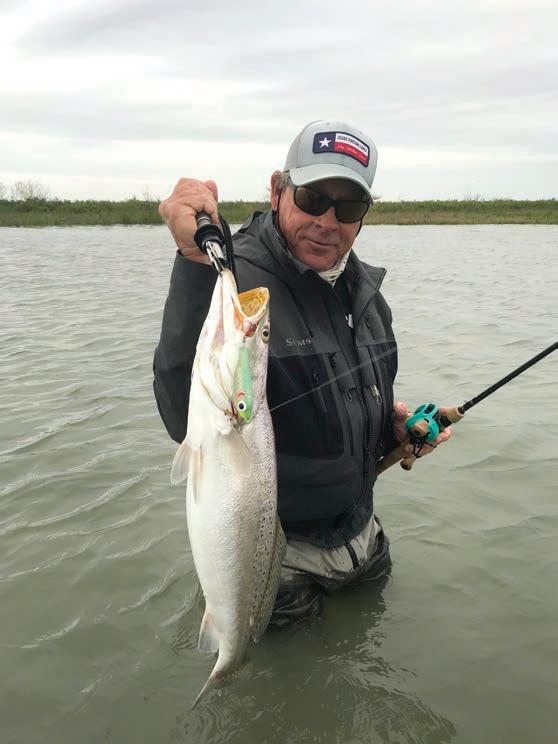
behind the choice of lure. Everyone knows that I am a huge fan of bass fishermen and my son Ryan has taught me tons in the way of choosing lures for the conditions in which the fish are holding versus throwing something you think might work. Corky fishing, as many refer to it, demonstrates this perfectly.
I by no means set out each day with only one style of lure in my box. I allow ALL the conditions of the day to dictate how I will select and present my lures. Expect the lure selections to change throughout the day, and be prepared to adjust when you notice the bite or even just the slightest change in the aggression level the fish exhibit. I throw MirrOlure products of all kinds, hard baits as well as soft plastics. I use 5-inch Bass Assassins, Custom Corkys and Soft Dines, Paul Brown Fat Boys, and in my redfish tournament days we threw gold, copper, silver, and even black spoons in super clear water. We threw Gulp when they wouldn’t eat anything else.
I steer away from baits with flimsy paddle-shaped tails, only because I don’t like taking time to change lures when perch have taken the tail off. Water time is critical when fishing and in tournament play it can make the difference between winning or not. IF you only throw one lure type you can only catch fish on that lure. This does not mean that this is the only lure they will eat or are eating, but it will be the only lure you will catch them on. I will step out and tell you that if that is your mindset, you have plenty to learn. I speak from experience and those that know my past will agree.
I have long been and still am a huge believer in soft plastics. I trust my skills with these types of lures and know that I am able to work the lure well enough to get bites most days. They can be terrific fishfinding tools as well. The trouble was that I was limiting my fishing
 Drew Donaldson enjoying steady action on a cold winter day.
Drew Donaldson enjoying steady action on a cold winter day.
education by limiting myself to one style of lure.
Cliff Webb would attest that I was not a good Corky fisherman when he met me. I was totally unaware of the many applications and situations in which the lure could be used. Likewise, Lowell Odom would attest that I was not a good 7M MirrOlure fisherman when he met me. It only took one day of getting my butt handed to me by each of these guys in tournament play to get me onboard with learning to use them. Both of these guys would also agree, I think, that I have and continue to work hard to become more versatile and increase my knowledge of these two lure types over the past twenty-five years.
I was raised throwing 52M MirrOlure baits, back when we removed the eyelet from the top, filling the hole with Mom’s nail polish, and then screwing it into the nose before there was a 51M series. This allowed the bait to run shallower and created side-to-side wobble like the Custom Corky, Soft Dine, and Double D have today – swimming action that mullet and menhaden are born with. It has always been all about that slow wobble and light glinting from the reflective sides that so perfectly imitate a live baitfish. Put a lure with this action and reflective capability in the midst of larger baitfish and good things are about to happen.
Open Camera and hover over QR Code. When link appears at top of screen tap to open in YouTube.



Winter is definitely my favorite time to fish and since I have increased my knowledge of lure selection for the conditions of the day, my ability to predict with some level of accuracy my client’s percentage of taking larger trout and better numbers of large trout has increased dramatically. Catching one a day is great but catching multiple fish of that size is a totally different game. Becoming more familiar with a wider variety of lure styles and applications will definitely help with this portion of your game. I have the best lure sponsors in the world. They preach credibility. “Use what they are eating and tell the truth“…and we will be good with it whether it is our lure or our competitor’s.
Yes, it is definitely Corky time and there are few takes that shake fishermen to the core more than a good Corky bite. Just remember to keep an open mind and pay attention to the changes that occur during your time on the water. It is the subtle changes that we pick up on and adjust to that allow you to become that angler that lands multiple trout of 28- to 30-inches in a day of fishing.
May your fishing always be catching! -Guide, Jay Watkins
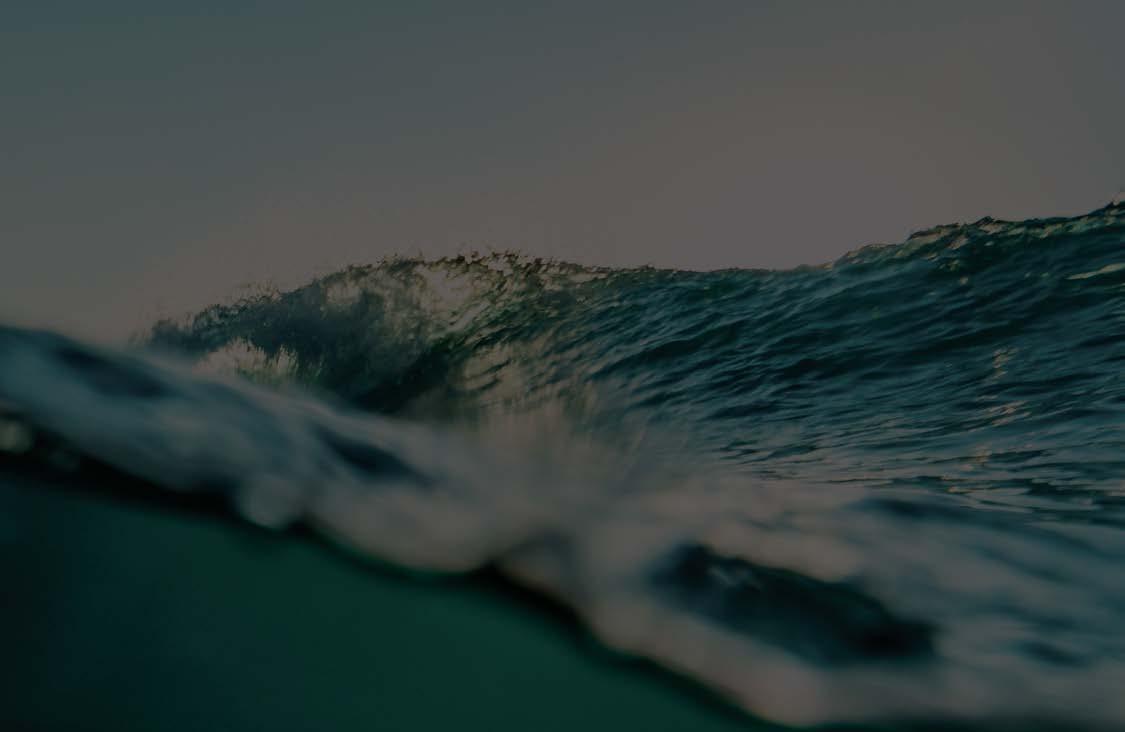
Jay Watkins has been a full-time fishing guide at Rockport, TX, for more than 20 years. Jay specializes in wading yearround for trout and redfish with artificial lures. Jay covers the Texas coast from San Antonio Bay to Corpus Christi Bay.
Telephone 361-729-9596 Email Jay@jaywatkins.com Website www.jaywatkins.com
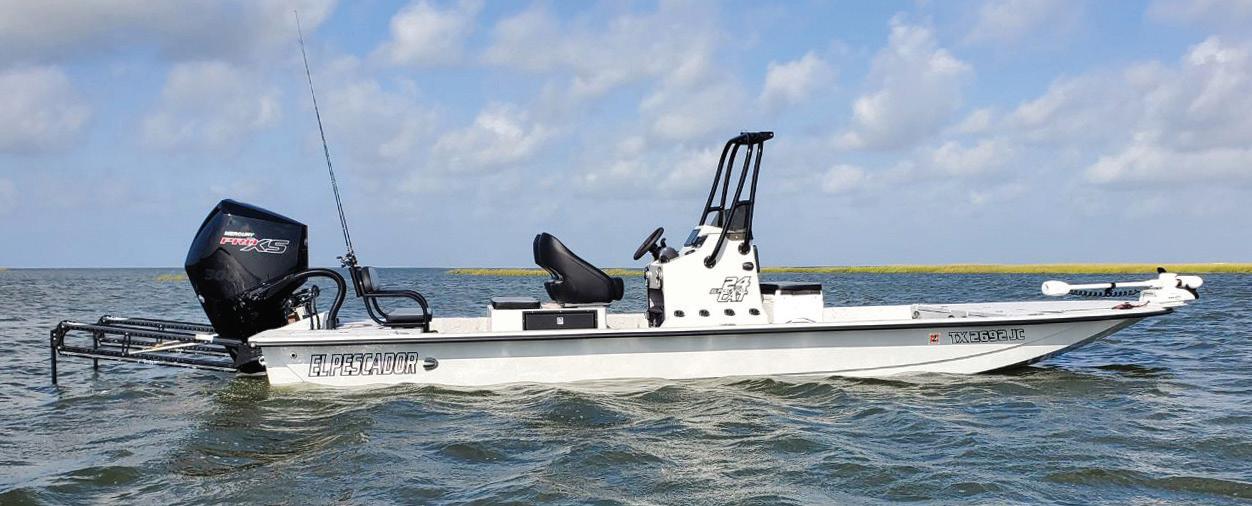






Nighttime anglers searching for Southern Flounder (Paralichthys lethostigma) have at least one thing in common – they don’t mind staying up late. While some anglers find success in the early morning, fishing for flounder at night is a popular way for other anglers, especially those using a gig, to catch their daily bag limit. Whether you are out with a guide on a boat or wading the flats, nighttime fishing is especially popular for flounder when compared to other popular sport fish like Red Drum (Sciaenops ocellatus) and Spotted Seatrout (Cynoscion nebulosus). However, flounder fishing at night is not an area that Texas Parks and Wildlife (TPWD) has been able to effectively study since the 1990s.
Flounder regulations have seen many changes in the past decade. To help address population decline, TPWD implemented a revision in minimum size limit from
14 inches to 15 inches in license year 2020 as well as a 6-week closure in the fall of 2021. But after listening to the public and looking at datasets from previous decades, it became clear that TPWD did not have enough data about flounder harvested at night. Based on earlier nighttime creel surveys conducted by TPWD, the majority of encounters where flounder were the primary target involved gigging as the means of harvest. TPWD’s routine creel surveys were not encountering this angler group because creel surveys track anglers’ daytime catches by conducting interviews with fishermen at boat ramps from 10am to 6pm in all Texas bay systems. By asking anglers and flounder gigging participants a series of questions regarding their landings, TPWD biologists can use that information, coupled with other sampling data, to identify population and harvest trends over time. Daytime creel surveys are an important part of TPWD’s data collection process, but more research is needed to address nighttime flounder gigging activity.
To address this issue, the Science and Policy Team in the Coastal Fisheries Division received a State Wildlife Grant in 2022 to study the nighttime flounder fishery for the next several years. The project will focus on nighttime flounder fishing on the middle coast, specifically in Matagorda, Aransas, and San Antonio Bays. A variety of methods will be used to capture information from flounder giggers and anglers, including nighttime creel surveys, nighttime roves, and the opportunity for flounder enthusiasts to self-report their landings through the TPWD My Hunt Harvest App. Nighttime creel surveys will be conducted by TPWD Coastal Fisheries staff to capture harvest information on flounder being caught between sunset and sunrise. Additionally, rove surveys, which use staff and traffic counters to count the number of boat trailers using a
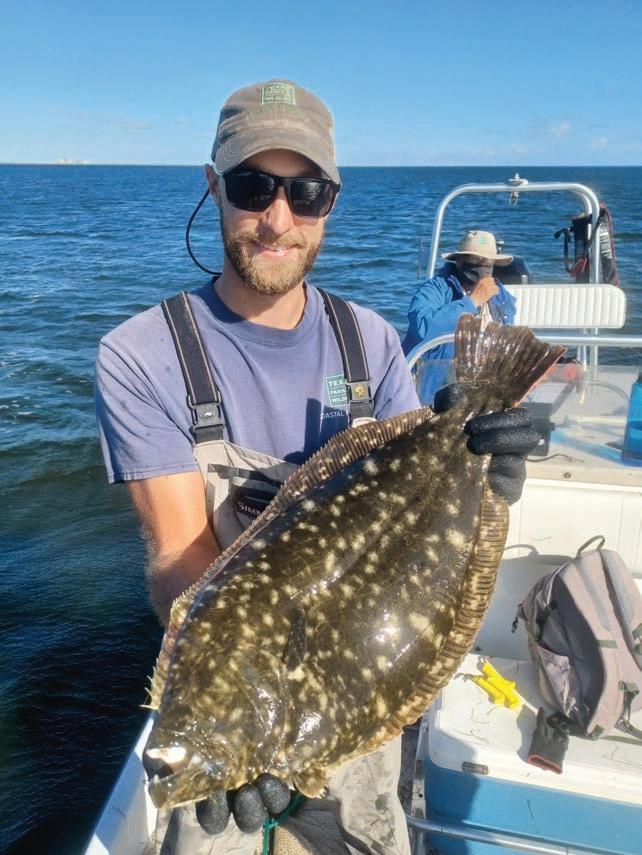
ramp, will be conducted overnight.

The My Hunt Harvest App will include a new flounder section where anglers in any bay system in Texas can report their flounder catch - day or night. There is no need to divulge your secret fishing spot, just add the number of flounder caught, which major bay system you fished, and the date to help add valuable data to this project.
By utilizing citizen science data through the self-reporting of flounder catches, TPWD will be able to more accurately estimate population size which can influence and improve management decisions. The more information anglers share with TPWD, the more accurate the data used in making management decisions. This new method of data collection for flounder gives anglers the opportunity to ensure this fishery is sustainable for future generations.
For additional project information or resources on how to use the My Hunt Harvest App, contact the Coastal Fisheries Science and Policy Team at cfish@tpwd.texas.gov.
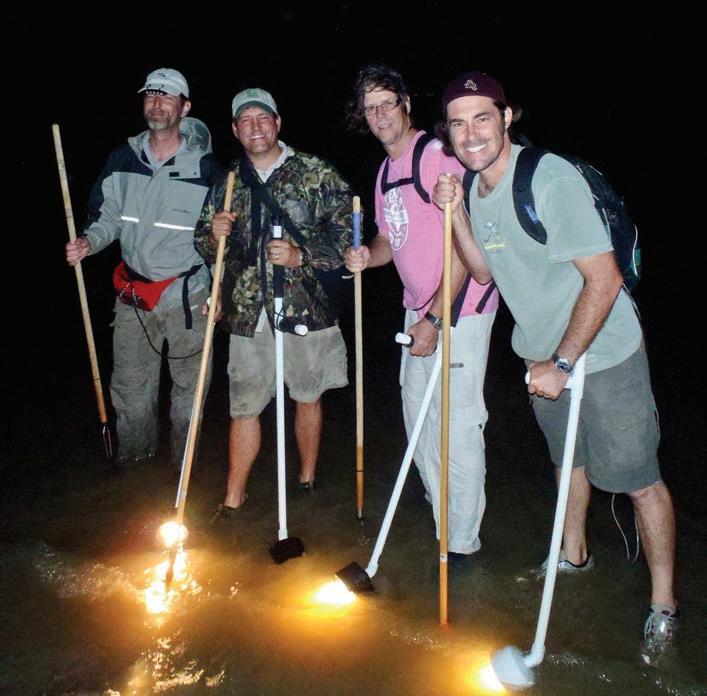
I always have mixed feelings as I prepare to write my January article. It seems the world is spinning faster and faster and time is speeding up with it. I never know where it all went and I’m always reluctant to start a new year. However, I was able to see some beautiful parts of the world and caught a few fish along the way. For that, I’m thankful.
Also of note, I believe that we’ve had some great conservation wins along the Gulf Coast this year. Here recently, TPWD closed some middle coast oyster reefs to protect them from being over harvested. As we all know, oysters play a key role in keeping our bays and estuaries healthy. On the other end of the coast, Florida has finally got some much needed support to help with their water quality improvement efforts. Biscayne Bay has been plagued with agriculture and industrial runoff which creates massive red tide algal blooms that have resulted in large fish kills. Another win for our neighbors in Louisiana, LDWF enacted a 45-day closure of their flounder fishery to conserve flounder stocks
during the spawning migration in an effort to boost the population. It’s great to see other state agencies taking action and for that, we are thankful!

Alright, enough of that, let’s move on to fishing! So far we have had a pretty good early winter season and as long as we don’t get any major freezes, I’m all for it. When it comes to talking about some of the better months to fish, January doesn’t get the recognition that it deserves. It may be cold and downright bitter some days, but I have learned a number of things during this time of the year. One of those being not going back into the marsh and sticking to the main lake instead.
During the winter months, fish tend to do things a little differently but they still follow a pattern. They are mostly trying to do two things: stay warm and eat. Sensing the seasonal drop in water temperatures, they will instinctively stage near deeper water where it tends to stay a few degrees warmer. However, on warmer days when the sun is shining, you can find fish making their way toward shorelines in their search for
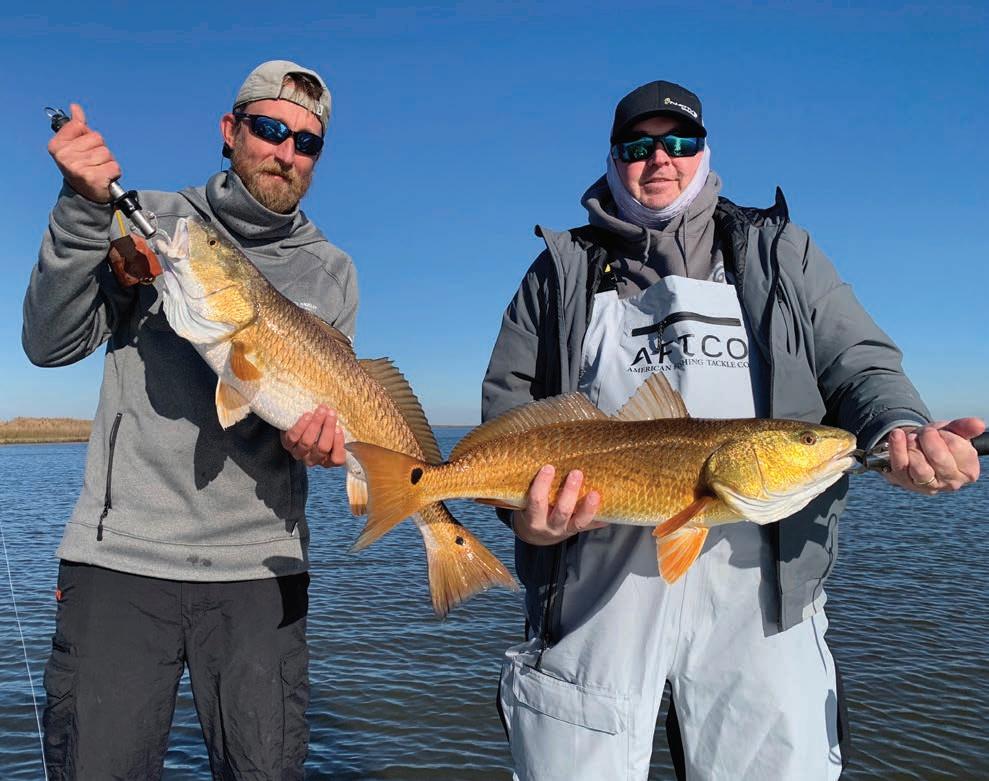
an easy meal. The thing is that they will never venture too far away from deep water so this is where the main lake shoreline comes into play.
When riding around looking at the shoreline, it seems that it all looks the same and can be puzzling at first for where to start. One of the first things I look for are bayous that connect the marsh to the main lake. I will start a few hundred yards before it and slowly work my way to it, and then past it about the same distance. I’ve always found these areas near the bayou mouths to be productive, in general. Other areas I like to focus on are any inconsistent pieces of shoreline. For example; points, pockets, smaller marsh drains, etc. These little differences will tend to hold more than a straight shoreline.
The other great thing about this time of year on the main lake is the water clarity. This provides a perfect opportunity to sight-cast fish as they come strolling down the shore. More importantly than that and especially on the upper coast, is that it gives an angler the opportunity to visually see the contour of the bottom. I have learned where small patches of reef and scattered shell exist that I would likely have never noticed. I discovered a large shell hump one day that I marked and returned to fish this past summer and the effort paid off handsomely. It was holding fish just as I had been hoping.
When it comes to sight-casting these fish, just about any lure will work. Typically this time of the year though, they are chasing mullet or any other finfish that might be available. I have found that on days when they may tend to be sluggish, a Chatterbait or Rat-L-Trap will put off enough vibration to encourage them to take a swipe at it. A few years back my

brother and I finished our trout fishing for the day and decided to cruise a shoreline in hope of finding some redfish. Being just a bit lazy, we decided to try sight-casting reds along the shoreline with the Corkys we had tied on. They got destroyed and proved to be a costly day lure wise, but getting to watch a big redfish completely inhale a Fat Boy is truly an awesome sight!

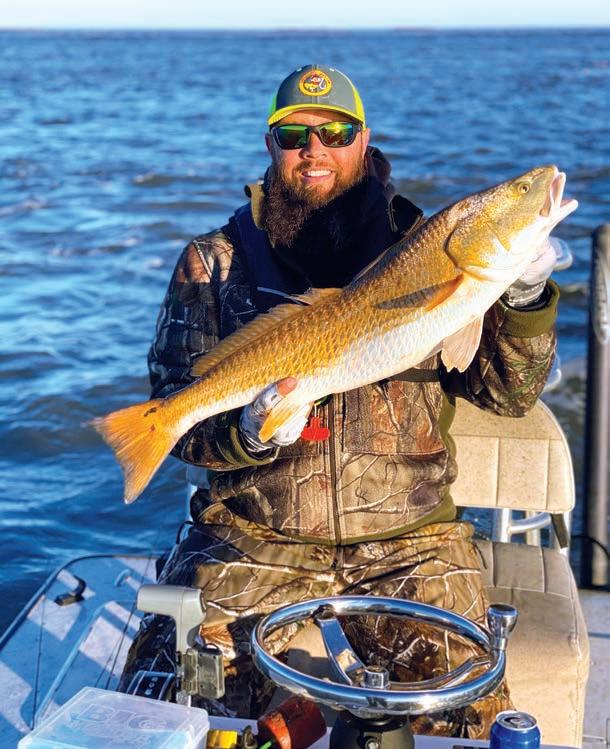
There are plenty of fishing opportunities in January and the whole month can be a spectacular time to be out on the water – weather permitting. If you do decide to go, be sure to dress appropriately and keep an eye on the weather forecast. Being on the water is not the place you want to be when a strong norther blows through. I hope everyone enjoyed their holidays and got to spend some time with family and friends. Cheers to the New Year!
Email: TexasKayakChronicles@yahoo.com Website: www.TexasKayakChronicles.com
Dave Roberts is an avid kayak-fishing enthusiast fishing primarily the inshore Upper Coast region with occasional adventures to surf and nearshore Gulf of Mexico. View The Video Open Camera and hover over QR Code. When link appears at top of screen tap to open in YouTube.
The CCA Texas Executive Board recently approved $162,000 in funding for the Sink Your ShucksTM initiative to support their oyster shell recycling efforts in the Corpus Christi area. This funding includes $152,000 to support the program’s basic operations for two years and $10,000 the program used to purchase two new trailers and make repairs to their existing trailer. These trailers will be used for the transportation of used oyster shells from local restaurants for recycling efforts.
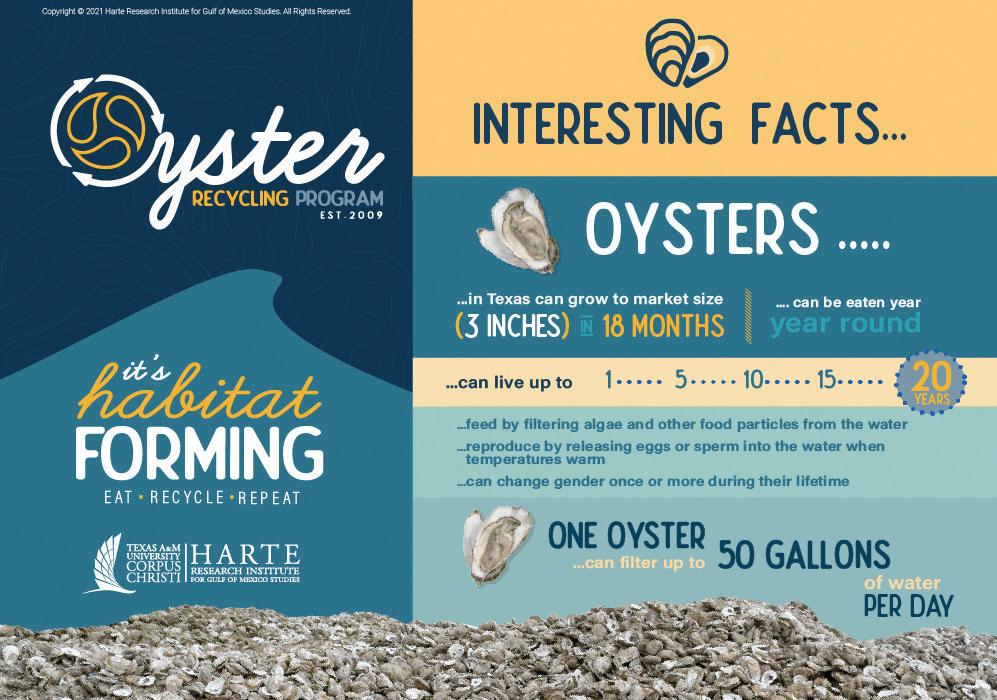
The Sink Your ShucksTM initiative was founded by the Harte Research Institute for Gulf of Mexico Studies (HRI) in 2009 and is now co-coordinated by Dr. Jennifer Pollack, Endowed Chair for Coastal Conservation and Restoration and the Texas Surf Conservancy (formerly the Texas Surf Museum). The program was the first in Texas that reclaims oyster shells from local restaurants and returns them to our local waters providing both substrate to form new reefs and habitat for fish, crabs and other organisms.
“We are eager to take control of Sink Your Shucks, which will advance TSC’s mission to protect and preserve the beaches, bays, and waterways of the Texas Gulf Coast,” said Brad Lomax, Founder of the
Texas Surf Museum, now the Texas Surf Conservancy. Lomax continued, “Sink Your Shucks is a legacy project that creates lasting, quantitative benefits for our local waters, and bridges distinct industries through shared values of environmental stewardship. This funding builds on thirteen years of hard work, community building, and successful shell reclamation. To date, over three million pounds of shell have been reclaimed, and 25 acres of reef habitat restored throughout Copano Bay, Aransas Bay, and St. Charles Bay.”
The $152,000 in funding approved by the CCA Texas Executive Board to help fund operations of the Sink Your ShucksTM program will last for a period of two years. In the future, CCA Texas will consider additional funding to help the program’s sustainability as it continues to secure funding from other sources. To date, other funding partners include Mike Shaw Toyota and the Port of Corpus Christi. CCA Texas is committed to creating a sustainable oyster fishery in Texas, and programs like Sink Your ShucksTM are a vital component of this effort.
A crucial aspect of this recycling program is the transportation of oyster shells by trailer from local restaurants to quarantine areas. The single trailer used
JOHNby the Sink Your ShucksTM program was in dire need of critical repairs. CCA Texas made the commitment to make repairs to the existing trailer as well as purchase a new one. The estimated total cost for the project was approximately $10,000. The funding for this project was generously supplied by James Avery Artisan Jewelry after the Texas-based company expressed an interest in supporting CCA Texas’ efforts to conserve the state’s coastal resources. As a result, HRI was able to purchase two new trailers, one more than they had originally envisioned, and make changes to their existing trailer. The vital funding of Sink Your ShucksTM enables the program to continue its critical work and move forward on a path to further growth. CCA Texas also funded $10,000 for the purchase of two new trailers for the Galveston Bay Foundation’s own oyster shell recycling program. In total, CCA Texas funded $20,000 for the purchase of four brand-new trailers for oyster recycling efforts. The Galveston Bay Foundation is a conservation nonprofit that has served as a guardian of Galveston Bay since 1987. Their mission is to conserve and enhance Galveston Bay as a healthy and productive place for generations to come.
CCA Texas believes it’s imperative that the management of our Texas oyster fishery continues to evolve by prioritizing the ecological and structural value of oysters in the water by safeguarding existing reefs and creating new ones. The recent actions taken by the Texas Parks and Wildlife Commission to prohibit oyster harvest in Ayres, Carlos, and Mesquite bays (Mesquite Bay complex) is a milestone step in this effort to conserve our state’s oyster fishery. Additionally, efforts such as the Sink Your ShucksTM program, the Galveston Bay Foundation’s Oyster Shell Recycling Program, and the evolution and growth of the Texas oyster mariculture program provide much-needed support. While these steps are bold and innovative, much more work lies ahead in the 2023 legislative session. CCA Texas will be an active voice and work
with other NGOs, academia, and industry stakeholders to ensure a sustainable Texas oyster fishery for current and future generations.

View The Video Open Camera and hover over QR Code. When link appears at top of screen tap to open in YouTube.

Oyster Bagging Event (CCA National and Yamaha), by Harte Research Institute
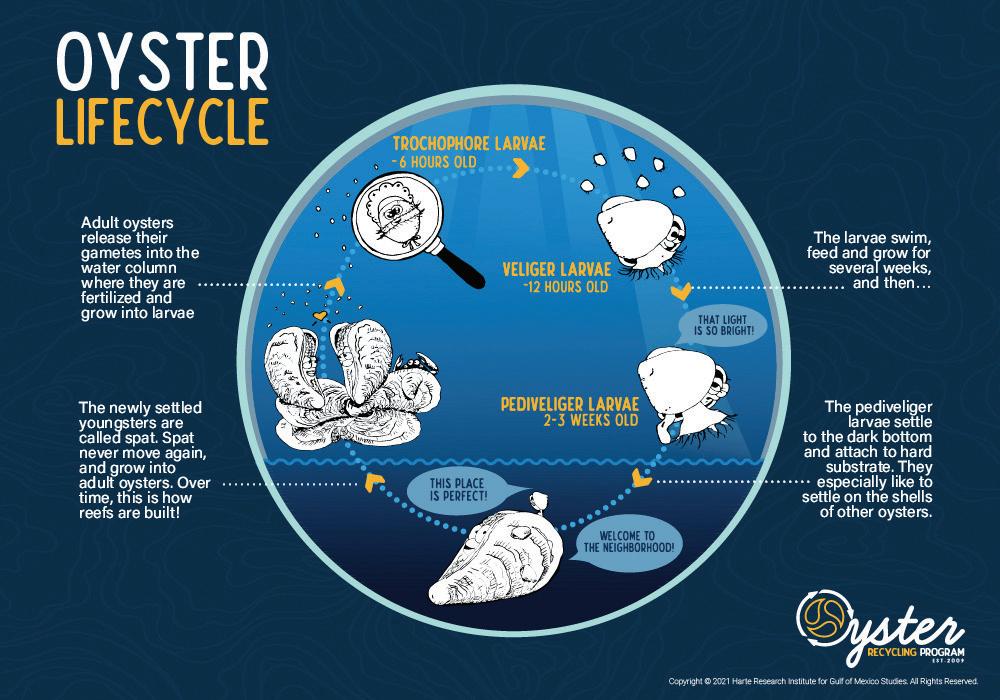
“The woodland lakes would be solitudes, indeed, did they lack the finishing touch to make the picture complete – the weird and mournful cry of the loon, as he calls to his mate or greets some new arrival. Who has ever paddled a canoe, or cast a fly, or pitched a tent in the north woods and has not stopped to listen to this wail of the wilderness? And what would the wilderness be without it?”
~ Arthur Cleveland Bent, ornithologistA common loon in summer is an eye-catching sight, with bright red eyes, a black-and-white checkered back, iridescent dark-green head, and prominent white necklace. During the winter, they molt into plainer gray and white plumage. Males and females look alike, although male loons are usually about 25 percent larger. Young common loons look similar to winter adults, but have more white on their head and back. This juvenile plumage is maintained through their first summer. Common loons are large swimming birds with long bodies that sit low in the water. They average 2.5 feet in length with a 5-foot wingspan and have dagger-like bills that are black in the breeding season and gray during the rest of the year. Loons are well equipped for submarine maneuvers. Unlike most birds, loons have solid bones that make them less buoyant and better at diving. They can quickly flatten their feathers to expel air
within their plumage, so they can dive quickly and swim fast underwater. Once below the surface, the loon’s heart slows down to conserve oxygen. Their legs are set far back on their bodies, which also helps them maneuver through water, but causes them to move awkwardly on land. They spend little time on land though, typically only going ashore to nest. Many people consider the loon a symbol of wilderness; its rich yodeling and moaning calls, heard by day or night, are iconic sounds of early summer in the north woods. In winter, common loons inhabit coastal waters and large southern lakes. Their genus, Gavia, is derived from the Latin term for an unidentified seabird and their species, immer, is derived from a Norwegian name for the bird, similar to the modern Icelandic word “himbrimi.” The word may be related to to Swedish immer and emmer, the grey or blackened ashes of a fire (referring to the loon’s dark plumage); or to the Latin immergo, to immerse.
This species is most abundant in Canada and the Northern United States. Common loons breed on lakes and other waterways from western Greenland west across Canada and the northernmost United States, including Alaska. However, they winter as far south as Baja California and Texas.
Loons are visual predators, locating fish by sight and diving to catch them. They generally hunt in water 6 to

 STEPHANIE
STEPHANIE
13 feet deep. Since they hunt by sight, loons require clean, clear water to successfully locate prey. Adult loons ingest most of their food items underwater where they catch them, but will bring larger items to the surface to eat. They can stay submerged for up to 5 minutes. The loon has sharp, rearward-pointing projections on the roof of its mouth and tongue that help it keep a firm hold on slippery fish. Before diving, they may swim on the surface with their head partly submerged to peer underwater. Loons do all their feeding during the day, when they can best see their prey. They eat fish and other aquatic animals, including crayfish, shrimp, leeches, frogs, mollusks, aquatic insects, and some aquatic vegetation. A hungry loon family can put away a lot of fish. It has been estimated that a family of loons (2 parents and 2 chicks) can eat over 60 pounds of fish per week.
Loons are agile swimmers, but they move pretty fast in the air, too. Migrating loons have been clocked flying at speeds more than 70 mph. Their legs are placed far back on their bodies, making them very powerful underwater swimmers. However, this arrangement also makes walking difficult for these birds. Because of this and their relatively heavy bodies, they require a long “runway” to take off for flight and can only do so from water. They need from 30 yards up to a quarter-mile (depending on the wind) for flapping their wings and running across the top of the water in order to gain enough speed for lift-off. Their legs trail out behind them while in flight, a characteristic shared by all loon species. When landing, loons make an inelegant belly flop, then skim along the water on their bellies to slow down. Migrating loons sometimes get into trouble when they mistake icy roads, parking lots, or other solid surfaces for water and can’t take off again after landing. A loon may also get stranded on a pond that is too small. They are also flightless for a few weeks after molting all of their wing feathers simultaneously in midwinter.
Common loons have a number of distinctive calls. One of the most well-known is a tremulous call used when they feel threatened, particularly in the vicinity of their nests. Another well-known call is the eerie, double-noted wail, which seems to function as a contact and gathering call. A third vocalization, the yodel, is given only by the male during territorial defense. Each male has his own characteristic yodel, but surprisingly, when a male loon changes territory, he changes his yodel. A fourth call, the hoot, is a one-note vocalization used by family members to locate each other. They are often very vocally active with nocturnal choruses. After sundown, many lakes in their northern range reverberate with the echoes of loon wails, yodels, and tremolos –which writer John McPhee called “the laugh of the deeply insane,” and may have given the bird it’s common North American name.
Loons are not typically social birds. You can usually find them foraging by themselves during the day. Though at night, they sometimes form loose flocks while they sleep. Even when they migrate, they typically, though not always, fly alone.
Common loons breed once per year in the spring and summer on lakes surrounded by forests in Canada and the Northern US. They are monogamous, with pair bonds lasting for multiple years. A breeding pair usually defends a territory consisting of an entire small lake or a protected bay within a large lake. They establish a territory of 60 to 200 acres, which they patrol regularly. Pairs exhibit high site fidelity and will reuse a nest site from the previous year if they successfully hatched chicks there. In spring, loon mates arrive back on their lake separately. If one year one of the mates doesn’t return,
the other will quickly pair up with another mate. The male defines his territory through yodeling. Courtship consists of swimming in circles, synchronous dives, and racing side by side across surface of water.
Both members of a pair build a large, mounded nest of dead marsh grasses, twigs, reeds, and other plants approximately 2 feet in diameter. The nest can be built either on the ground or afloat in shallow water, ideally near deep water so they can swim to and from the nest without being seen by predators. They favor nest sites on small islands or peninsulas but will also build along well-vegetated shorelines. When the nest is complete, the female lays 1 to 3 brown spotted eggs, one or two days apart. Male and female take turns incubating their eggs and protecting the nest, beginning after the first egg has been laid. Incubation lasts for around 29 days. The chicks hatch asynchronously, up to a day apart. They stay in the nest for a day or two after hatching, after which time they leave the nest with the parents and return to shore only rarely. The dark, downy chicks can swim and dive after only two to three days and have an endearing habit of riding on their parents’ backs, usually for the first seven to ten days after hatching. The parents feed the chicks whole food every hour from the time of hatching until they are up to three months old. They protect the chicks from predators by vocalizing and swimming away to distract them from the chicks. When that doesn’t work, loons sometimes attack the predator by rushing at it and attempting to impale it through the abdomen or the back of the head or neck. Chicks remain with their parents for up to three months, until they are able to fly. The parents head off on migration in the fall, leaving juveniles to gather into flocks on northern lakes and make their own journey south a few weeks later. Once the juveniles reach coastal waters on the ocean, they stay there for the next two to three years before heading back north to breed. The oldest recorded common loon was a female, and at least 29 years and 10 months old when she was spotted in Michigan in 2016 and identified by her band. She was originally banded in the same state in 1989.
Common loons are predators, so they accumulate toxins, such as mercury or heavy metals, that are concentrated by every rung up the food chain. Lead poisoning through ingestion of fishing sinkers, which loons mistake for grit, is another major cause of mortality, and these birds face additional dangers from oil spills, fishing nets, habitat loss, and climate change.
North American common loon populations are stable overall. They depend on clean water and are sensitive to the effects of pollution and human disturbances. They have special conservation status in some states where they are listed as threatened, though the IUCN Red List classifies them as Least Concern. They are also protected by the U.S. Migratory Bird Act.
Where I learned about loons, and you can too!
Michigan State University mnfi.anr.msu.edu/species/description/10862/Gavia-immer
Animal Diversity Web animaldiversity.org/accounts/Gavia_immer/
IUCN Red List www.iucnredlist.org/species/22697842/132607418


Folks who make a living in the fishing industry gratefully enjoy many adventurous journeys. As someone who’s proud to work as a fishing guide, I’m often engulfed in new and interesting experiences. I do glean joy from the release of newly developed gear and technologies, but mostly, the excitement over the angling outings themselves earns my forward-facing focus.
It’s important to pause and reflect back on things as well, with the hopes of fully appreciating some of life’s finer moments. Aside from harvesting healthy food for the family, we head out into the wet and wild outdoors mostly for sport. While we often take photos to preserve magical moments, in some instances, the memories can be even more intense without photos. I’ve held massive trout in the water for an extra five seconds to admire and appreciate them for this very reason. Some of these mesmerizing moments burn permanent images into the metaphorical gallery of our memory.
As we end one year and start another, I’d like to reflect back on some of 2022’s special moments. The weather over the past twelve months has been both highly variable and wildly unpredictable along the South Texas coast. The creatures which inhabit the surf endured some unusual hardships over the past year. January started off warm, and many of us thought
the lingering Indian Summer would bring us some welcome treats.
Several precise variables lined up perfectly right off the bat in the first month of the year, introducing the potential for one of the expected treats. The windows we get for pursuing mako sharks are generally shortlived, because the speedy open-ocean predators rarely venture close to the Texas shoreline. Soon after the turn of the new year, we hooked two makos, before a harsh cold spell pushed the pelagic hunters offshore in February. By March, the weather warmed again, and I helped my buddy Ron Richmond release just the seventh land-based mako shark brought to hand on a Texas beach. Obviously, this ultra-rare encounter with a creature that seems like a unicorn in the surf ranks high on the list of special moments for Ron and me.
By the time spring picked up full steam, the action on the beaches became lackluster. Though our weather did not cooperate much, and a significant giant bull shark run just did not materialize, I did manage to put a handful of bulls measuring more than eight feet on the beach. Encounters with these brutes always provides plenty of excitement and fond memories.
While they did not appear in huge numbers, the scalloped hammers showed up in greater numbers this
year than they have over the past three or four. Historically, their run begins at the end of March, in some years lasting through April and well into May. Mysteriously, their run along the Texas coast has been quite unimpressive over recent years, so we felt grateful for what we experienced this year.
As we entered the middle of the year and the warm summer months arrived, the big sharks began to show up. The Seigmund boys caught our longest shark, a thirteen-foot great hammerhead, which earned a special place on my list of cherished memories as both a guide and an angler in general. To my knowledge, this beast was the first and only hammer of such impressive length to be successfully caught and released in the Texas surf.
Several factors contributed to the successful release, but teamwork executed in a timely manner was the most important. Hammerheads are more fragile than most other sharks. They live in a high-paced world. When hooked , they often race off like rockets, and don’t stop until they have no more fuel to burn. Any hammerhead measuring ten feet or more is extremely hard to handle and release. Each foot above ten seems to generate exponentially greater difficulty for anglers hoping to handle these monsters successfully. Significantly, we released all the big hammers we managed to wrestle into the shallows this past year, including another twelve-footer.
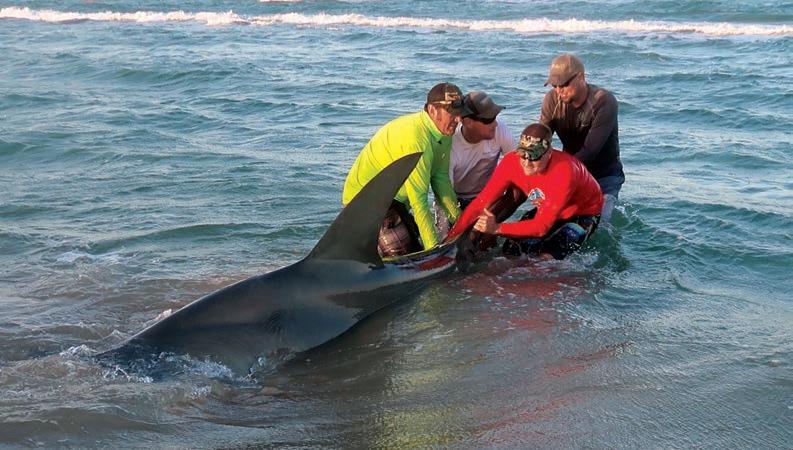
The year’s hottest season brought more environmental anomalies. The mysterious cold-water upwellings on Padre Island generated water temps more than ten degrees below normal for several weeks. While people may think cooler water temperatures would be advantageous to anglers in the summer months, they aren’t. The only advantage presented by cool water in the summer surf is the small window it creates for catching an elusive dusky shark. The dusky ranks second only to the mako as the rarest shark landed from the beach. While I did not land any of these rare sharks on my trips, I know some lucky people who did.

As we rolled through the summer, the tiger sharks began snapping their
 Deon Hunter assisting with the release of a large great hammerhead.
Large hammerheads are notoriously difficult to handle and release successfully. Timely work from all hands available helped insure the success of this one.
Deon Hunter assisting with the release of a large great hammerhead.
Large hammerheads are notoriously difficult to handle and release successfully. Timely work from all hands available helped insure the success of this one.
jaws earnestly. The warm, stagnant waters in the second half of summer create the perfect scenario for “tiger-time.” More tiger sharks are caught from the Texas surf in August than in any other month, so I target them every time I make a trip to the coast during those weeks. In essence, the tiger shark is my spirit animal. In 2022, I ended up putting double-digit tigers on the beach, which has long been a personal goal for every year.
Three of this year’s tigers were massive twelve-footers, the largest a 12’8” monster caught by client James Fazio, which pushed the thousand pound mark. This is personally the largest tiger shark in length and girth I have seen caught off our beaches, and is likely the biggest tiger caught in at least the last decade in the Texas surf. This incredible creature, like all the other tigers and hammers we caught all year, was successfully released.
A stubborn summer delayed the onset of autumn this year. The hot weather lingered through Halloween and into November. In the span of a week, in the middle of the Thanksgiving month, water temps in the bays and surf zones dropped as much as twenty degrees. The rapid change from one season to the next seems to have become the norm in the Lone Star State. This year’s event pushed out the warm-water sharks and brought in our flagship winter shark—the sandbar shark. Sandbar sharks are like blacktips on steroids, with a slightly stockier build. On the first trip after the major cool-down in November, I put the Sisk family kids on some welcoming sandbar sharks. The rest of the winter of ‘22-’23 should
consist of solid sandbar/pompano/and bull red action.
Looking forward to the surf fishing expectations for 2023, I can predict more stellar shark action. Will we get another rare mako window? Will we get a run of energetic scalloped hammerheads in the spring? These questions remain unanswered, but I do expect the behemoth bulls to return late in the spring, and we know the tigers and hammers will become active when the weather warms up to summer heights.
No matter what nature throws at us, we’ll be ready. Texas anglers rank among the best in the world, partly because we have to adapt to supremely inconsistent, often harsh conditions. The intensity and uncertainty help make our fishery special. This is why I love sharing experiences and adventures with people of all ages and abilities. Though I’m booked solid for all the weekends during the summer of 2023, I do still have some availability on the weekdays and plenty more days during the expected frenzies of spring.
For the past decade Eric ‘Oz’ Ozolins has been promoting shark catch and release and assisting various shark research programs. Eric offers guided shark fishing on Padre Island National Seashore. Also renowned for extreme kayak big game fishing, Eric is the owner of Catch Sharks Tackle Company.
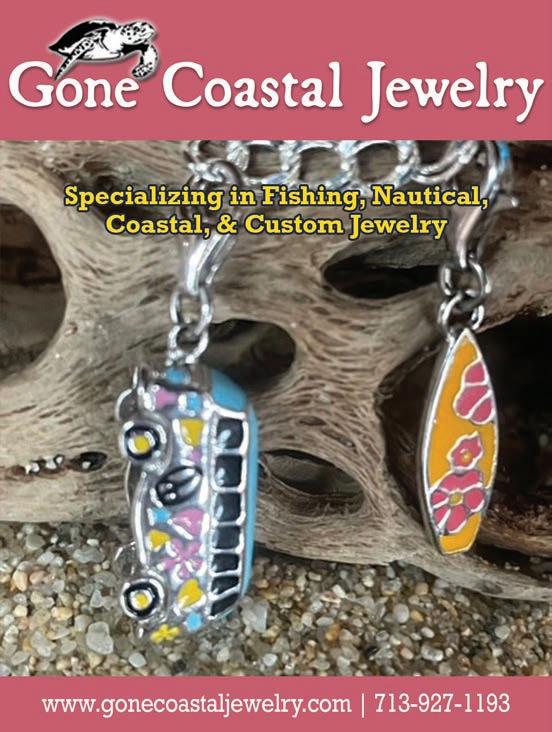
Email oz@oceanepics.com Websites oceanepics.com | catchsharks.com
...continued from page 39
US Fish & Wildlife Service www.fws.gov/species/common-loon-gavia-immer Audubon www.audubon.org/field-guide/bird/common-loon
Cornell Lab of Ornithology birdsoftheworld.org/bow/species/comloo/cur/introduction www.allaboutbirds.org/guide/Common_Loon/overview www.allaboutbirds.org/guide/Common_Loon/lifehistory
The National Wildlife Federation www.nwf.org/Educational-Resources/Wildlife-Guide/Birds/Common-Loon
American Bird Conservancy abcbirds.org/bird/common-loon/ Wikipedia en.wikipedia.org/wiki/Common_loon
Open Camera and hover over QR Code. When link appears at top of screen tap to open in YouTube.
Nature’s Greatest Sounds: Loon Calls in Maine

Do you love offshore fishing? Are you interested in the health of our Gulf of Mexico fisheries? Return ‘Em Right is your chance to join a community of likeminded anglers, using and encouraging others to use best release practices to protect the future of fishing. Learn to improve survival of released reef fish through our 15-minute training and receive $100 worth of reef fish release gear for FREE .

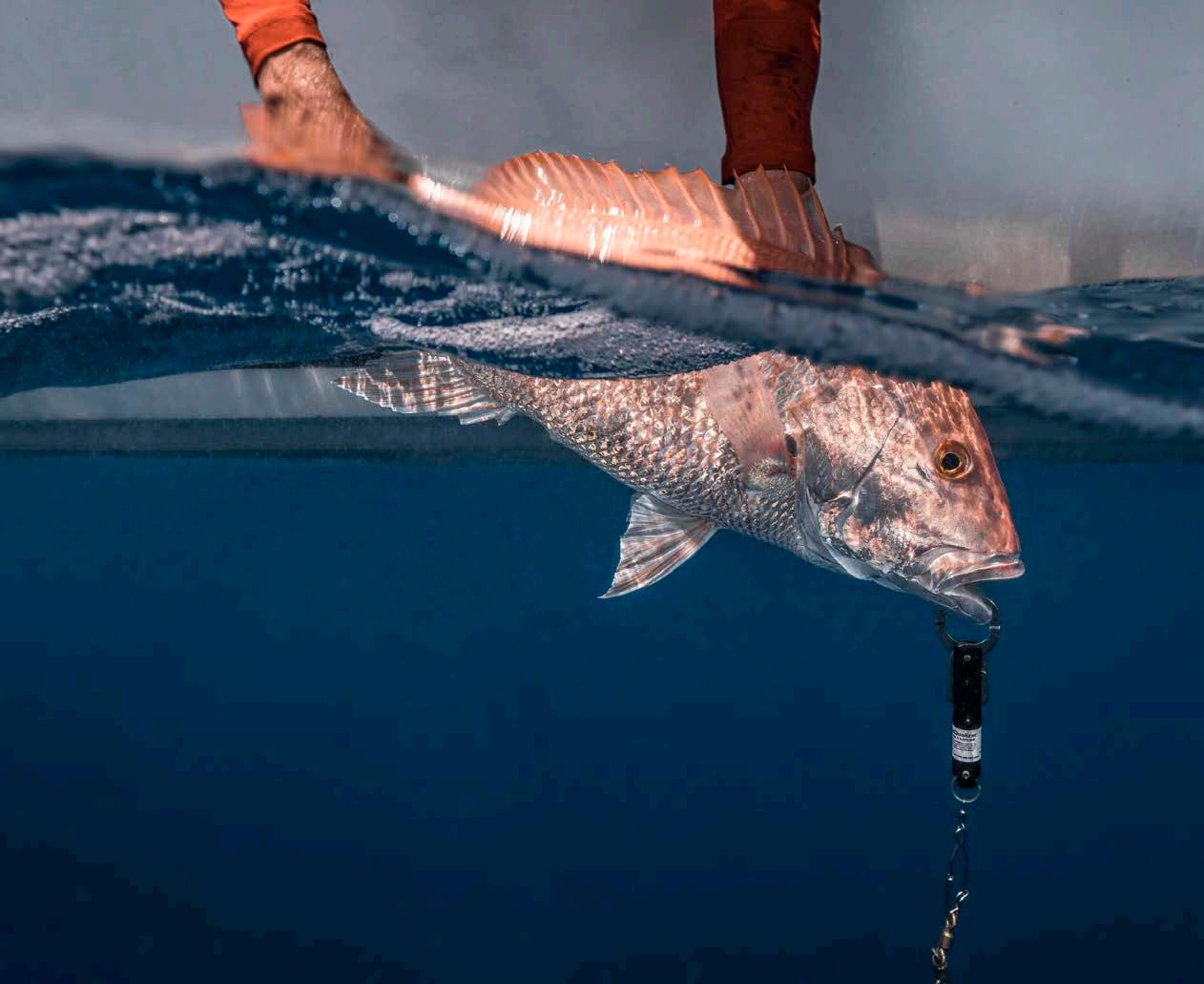
Introducing: Grundéns

GORE-TEX® PRO SHELL FABRIC - Body mapped 3-Layer and 4-Layer Gore-Tex PRO Fabric provides breathability where you want it and abrasion resistance where you need it.
FUSED AND CONTOURED SUSPENSION SYSTEM - Inspired by premium climbing harnesses, this system provides all day comfort, stretch, and complete customization.
DOUBLE WEAVE STRETCH WOVEN GRAVEL GUARD - Double weaves stretch woven gravel guard is patterned to stay secure when wading without the need for a boot hook.
TITANIUM-ALPHA NEOPRENE BOOTIES - Increasing heat retention up to 40% Grundéns neoprene booties use a titanium alloy layer to keep your feet warm by reflecting body temperature. An industry first solution to cold feet.

Men’s Available in 13 Sizes / Women’s Boundary Available in 11 Sizes Grundens.com

PENN introduces the next generation of PENN Fierce spinning reels. Feature-rich, the PENN Fierce IV reels offer high-quality, proven components at an affordable price. Designed to play a role in any saltwater situation, the Fierce IV reels/combos and the Fierce IV LE combos combine value and performance. The reels feature a full metal body and side plate with graphite technobalanced rotors for a smooth retrieve every cast. The four sealed stainless-steel bearings are protected from saltwater corrosion, and the HT-100 carbon fiber drag system is strong enough to handle big fish but smooth enough to play them around the boat. Available in sizes ranging from 1000 to 8000.
Available: September 2022 Price: $79.99 - $139.99 For more information about PENN Fishing products visit www.PennFishing.com
ForEverlast introduces the most practical knife kit for the outdoorsmen or women in your life including a large carving knife, filet knife, and gut hook/caping knife. Also comes with a cutting board, sharpener, and perfectly constructed case for keeping all organized. The ergonomic handle along with the forged stainless steel blades combine for both a durable and longlasting set of knives that hold can hold an edge for all your cutting needs! Available in our online store or at your favorite tackle/ outdoor retailer! MSRP $49.99 We Live Hunting and Fishing! www.ForEverlastonline.com



Brand new for 2023, Bass Assassin announces their Artemis Shad. A 5-inch soft plastic paddletail with a chunky profile, the perfect size and shape to imitate finger mullet, one of the primary forage species of all saltwater gamefish. Available in 16 fish-attracting colors to match all water clarity and light conditions, with the pulsating thump only a paddletail can create. Now available at your favorite tackle shop and outdoors store. www.BassAssassin.com
Built for big, tough predators, the DieZel Eye Jighead is highlighted by its hallmark Eye Strike® 3D eye design, creating a prominent strike target. Custom, heavy-duty 6/0 or 8/0 black nickel, needlepoint hooks are ‘tri-forged’ on three sides for superior strength and sharpness. Jighead is constructed with dual, conical keeper barbs that grip ElaZtech plastics securely; a molded retainer collar accepts EZ Skirts for dressing up soft plastic presentations. Oversized 6/0 or 8/0 Tri-Forge Power Hook pairs exceptionally with 5” and 7” DieZel MinnowZ and other larger ElaZtech bait profiles. Offered in 3-, 2-, 1-, ¾-, ½- and 3/8-ounce weights in red, glow, chartreuse eye patterns. MSRP $5.99 to $11.99 per 2-pack, by size. www.ZManFishing.com. (ICAST 2022 BEST OF SHOW - TERMINAL TACKLE)

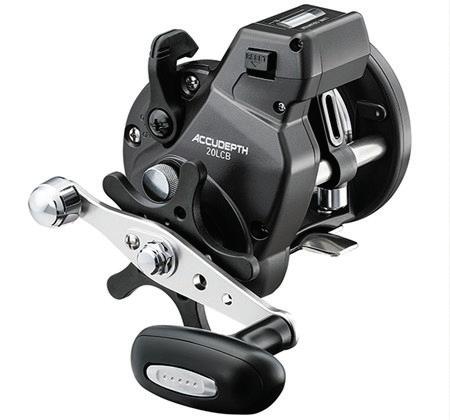
Daiwa has given its Accudepth Line Counter series a sharp new generation gray finish while leaving intact the internal guts that have made these reels an industry standard for trolling a wide variety of species in both freshwater and saltwater environments. That’s great news for those who have grown to appreciate the flawless performance, durability and direct-drive line-counter precision of this long-time Daiwa favorite. Accudepth LC reels feature a built-in direct-drive line counter that makes them ideal for downriggers, diving planers or flat line trolling spreads. The length of line anglers pay out is measured in feet, which makes it easy to set accurate and repeatable trolling patterns at selected water depths and distances behind the boat.
MSRP: $109.99 - $139.99 Learn more at: www.Daiwa.us
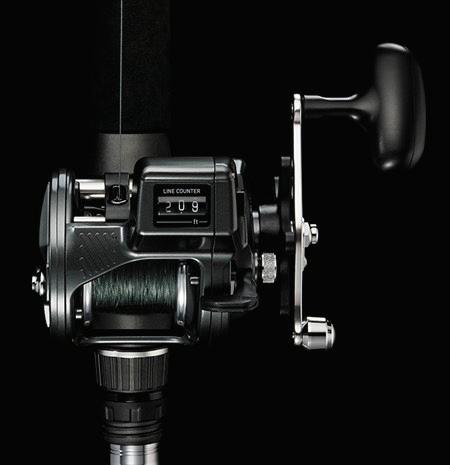
Bink Grimes is a full-time fishing and hunting guide, freelance writer and photographer, and owner of Sunrise Lodge on Matagorda Bay.


Telephone 979-241-1705
Email binkgrimes@sbcglobal.net Website matagordasunriselodge.com
What else are you going to do in January if you don’t fish or duck hunt?
Deer season ends the first weekend and the long January/February winter begins. It is depressing sometimes just sitting at home on a windblown, gray, dreary day.
But I’m an optimist.
There are more good days than bad; and, January in Matagorda can be just like November and December if the weather cooperates. Of course, the wader fishermen love January. Hard to beat a slow-sinking Corky, MirrOdine, or Texas Custom Corky. Choose your color – all the new shades are making waves.
I like to work near deep water, and our deep water is in the ditch or, properly termed, Intracoastal Waterway. Reefs adjacent to deep channels give you the best chance for gator trout. When the cold blows across the region, fish ease off in the warmer, deep channel. When the sun warms a day or two later, those big fish gingerly loaf out onto the shell and mud flats looking for one big meal.
Redfish have been a mainstay for the past year. Winter reds are hanging around sloughs and guts and traveling in and out of the bayous with the tides.
The Colorado River has been a game-changer for most of the year as well, giving us a safe haven out of the wind on those days when it blows your hat off.
For most of the year we have been in a drought with higher than normal salinity levels; however, that has changed with November and December rains, and fish are responding to the sweet water mixing with our estuaries.
We like to drift over the same shell we drift all year long. The cool thing is that same guy has a pretty good chance of catching the biggest trout of his lifetime on a Bass Assassin, Down South Lure, or MirrOlure Lil John.
Mind you, they don’t bite everyday – cold water temps and high pressure cure that – however, there is always a chance of a solid winter Matagorda bite.
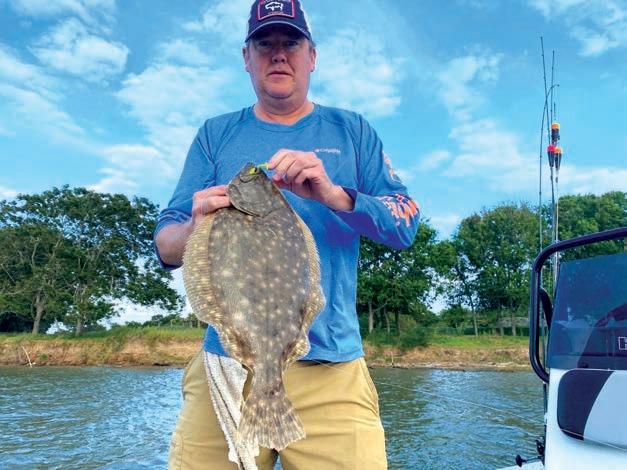
Tides are normally at least a foot to two feet below normal this time of year so redfish are targeted in deeper sloughs and bayous. When the water really blows out there are some spots that hold redfish at the mouths of draining lakes. There are multiple spots that save a day with temperatures in the 30s and winds gusting at 25 knots from the north.
Since many of my fishing clients duck hunt with me as well, I like to use the weather to my advantage and hunt the bad weather days and fish the chilly, calm days after a passing front.
That doesn’t always work out, but we always try to be honest with hunters/anglers and stack the best odds in our favor.
In January we always talk about how we can be better people and better stewards of our cities, states, and nation. In fishing terms, let’s continue to err on the side of conservation with speckled trout. Let’s put back more than we take. Let’s quit killing fish for the sake of a social media post.
Let’s be better and our bays will respond with producing better quality fish. Think about it – give catch and release a try. It certainly won’t hurt anything, except maybe an ego or two.
For information on fishing, lodging, rentals or real estate, find us at Matagorda Sunrise Lodge and Properties, LLC.
View The Video Open Camera and hover over QR Code. When link appears at top of screen tap to open in YouTube.
Matagorda Cast and Blast Opportunities Continue in January



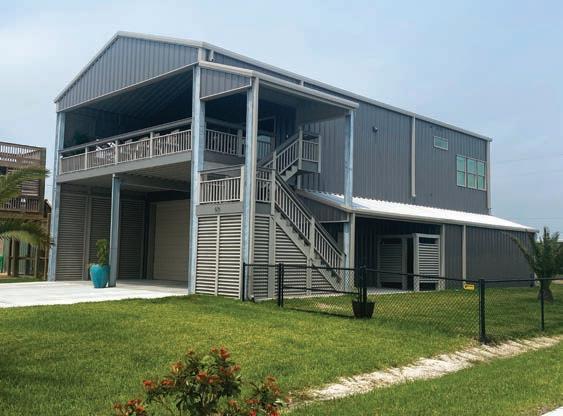
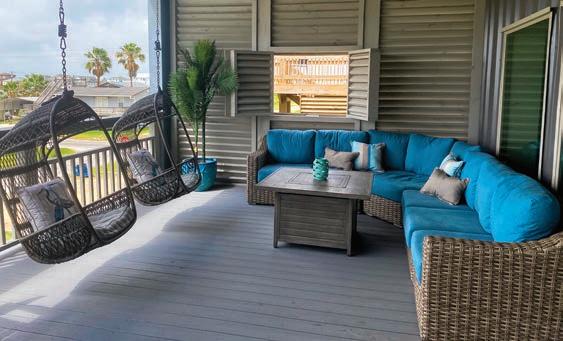



Captain Shellie Gray was born in Port Lavaca and has been guiding in the Seadrift/Port O’Connor area full time for the past 19 years. Shellie specializes in wading for trout and redfish year round with artificial lures.

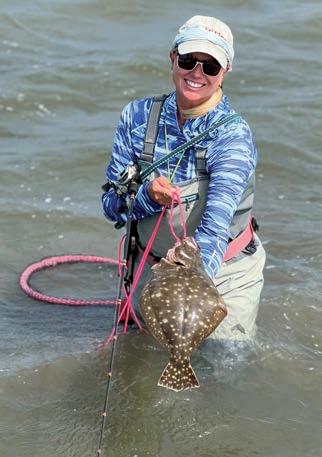

Telephone 361-785-6708
Email bayrats@tisd.net Website www.bayrat.com Facebook @captsgaryandshelliegray
In general, I would say December fishing in the POC/Seadrift region was about as good as it gets. Granted, we had to deal with some cold fronts that brought enough rain to fill ditches and flood pastures, but these are minor inconveniences compared with the “shot in the arm” timely rainfall and runoff contribute to the health of our estuaries. Keep an eye on the weather forecasts, though. December’s cold fronts were just a precursor of what will be happening in the month of January.
Finger-numbing cold and blustery winds will keep most fair weather anglers off the water in January. But for any suffering cabin fever or stressed from a busy holiday season, getting out on the bay can be just what the doctor ordered, no matter what the weather might be.
Colder water temperatures during winter brings many seasonal changes to the ecosystem. Even the tiniest of microorganisms that inhabit our normally warmer waters are greatly diminished, often creating exceptional water clarity. And while high winds from cold fronts can sometimes make even deeper water somewhat off-colored, our protected back lakes will remain relatively clear except during the windiest of days. While I have to admit I am enamored of gin-clear water, it brings its own set of challenges. One of which is selecting lure colors that will draw strikes.
Fishermen are captivated by the vast array of lure colors, but less can definitely be more this time of year. Most of the forage species that gamefish thrive on actually have little natural coloration, a feature that allows them to blend into their surroundings and avoid predation. As an example; juvenile shrimp are almost completely translucent. So, to be successful when fishing winterclear water, I believe anglers should avoid the bright colors, opting instead for more natural shades.
The Bass Assassin 3.5-inch Die Dapper in Crystal Shad and Houdini are two that I find very effective.
The Die Dapper is also impregnated with
BANG fish attractant making them harder for fish to resist. When fishing in colder weather it is imperative to SLOW DOWN. Work the area you are fishing slowly and carefully. Make multiple long casts in a fan pattern and retrieve your offering slowly, allowing your bait to touch bottom occasionally. Fish are coldblooded and can become rather sluggish when the water temperatures drop. Getting it right in their face is often necessary to draw a strike…which is the main reason I recommend the low and slow, fancast presentation.
I am not going to get into the argument of mono versus braided fishing line because I honestly believe they each have their place in various situations. However, I will say that winter is probably the season when the no-stretch aspect of braid offers a distinct advantage. Trout, especially, are known to make very short, subtle strikes in cold conditions. So, as much as I love my mono in warmer seasons, braid offers this advantage during winter.
Locations I will be fishing will be dependent on the wind. No surprise that San Antonio Bay reefs will be go-to spots on calm days. Lately the reefs have been producing good numbers of trout, mostly of decent size, but I have to admit it is not uncommon to hit reefs where we find only undersized trout, and lots of them. When you come across this scenario it is best to leave these small guys alone and move to a different reef if your goal for the day is a few slot-sized keepers. These smaller trout are eager to eat and tend to inhale your offerings, making it difficult to remove the hook without injuring them.
I expect to see good numbers of redfish continuing to hold in back lakes throughout the month. All of these lakes are relatively shallow but the majority can be navigated safely with shallow running boats during average tide conditions. However – when a strong norther blows through – the tide can drop dramatically and extreme caution is advised. If ever in doubt, it is highly advisable to take a deeper, safer route.
I want to wish all of you a healthy and prosperous new year. I believe we can all agree that the last few years have been trying to say the least. I think a good rule to follow is to treat people you encounter at the dock and on the water the way you would want to be treated. Let’s all set a goal to make at least one person feel good daily.


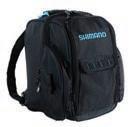
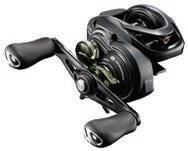



David Rowsey has 30 years in Baffin and Upper Laguna Madre; trophy trout with artificial lures is his specialty. David has a great passion for conservation and encourages catch and release of trophy fish.
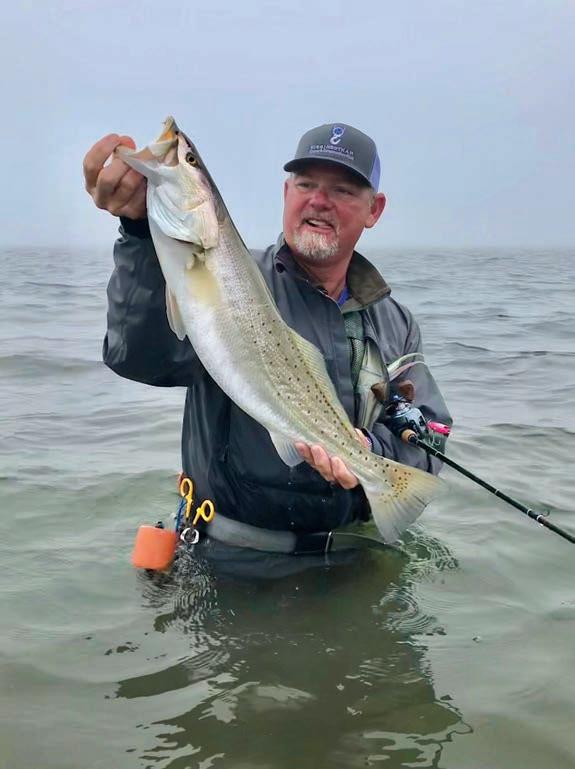

Telephone 361-960-0340 Website www.DavidRowsey.com Email david.rowsey@yahoo.com @captdavidrowsey
Here we go again; another dang year passing. The rate at which they pass now seems like flashes of light with some trout mixed in. Seems only yesterday I was in my younger-twenties crashing across Baffin in a 14’ scooter from hours before the sun came up until well after it went down. Only to wake up and do it all over again.
December produced better fish for us here at the end of ‘22 versus where we were at the same time in ‘21. The freeze of February 2021 had many of us very concerned about what the future would hold. As things happen by God’s hand, we ended up having an amazing season in 2022, thanks to some fish that found their way into the Laguna Madre via Corpus Christi Bay and the Gulf of Mexico. That carryover seems to be jump starting us into this new winter season of 2023 and the averages are definitely up.
I’m excited about what will come to hand for my clients this year. I’m not sure if I will ever have years again where you land 70-100 trout over seven pounds, but I truly believe we have the format to get it back if TPWD will keep our bag limits to three trout per day. In addition, I would personally prefer to see the top end of the slot revised downward to twenty or twentyone inches. These things, along with all the folks doing straight up catch and release, could put us right back in the big leagues again. Catch, photo, release!
January is just an absolute stud of a month to catch a trophy sized trout. In fact, my largest ever came in this month, many years ago. She was a big 11.5-pounder that swam off healthy after I got to soak up her grandness. As luck would have it I was fishing alone that day and do not even have a photo of her… other than what is burned into my memory. Good enough for me.
Used to be that January was a “sleeper” month. Minimal boat traffic, cold weather, hunting season, etc., all played a role, but more than a few savvy anglers have figured it out and sharing the water is more common of late. Saying that, there’s still enough to go around if everybody uses common sense and some old school manners. Come February, a branded few earn their medals in asshole-ness and become the talk of the marina and text chains flying around Baffin. Don’t be that guy!
As mentioned last month, patterns are pretty straightforward throughout these colder months. Shallow feeding grounds that can warm up fast in sunlight, with deepwater access is the ideal scenario, on paper anyway. Mix in some good pothole structure over tacky mud, signs of bait activity, and you are well on your way to good days.
A couple things many fishermen overlook, in my opinion, is
moving too fast and not exercising enough patience. I’m talking about big trout here, way less than 1% of the total population. You are not going to catch one every cast. If the area has the characteristics mentioned above and you do your part, chances are there will be a ringer within a cast or slow wade from you. Keep in mind, trout are opportunistic feeders, but even they do not feed 24/7. Slow down, be confident, make good presentations with the appropriate lure for the situation, and grind it out if need be.
Crashing through the water like a Labrador retriever and bombing potholes in 52° water with topwaters as long as your forearm is not going to work out well for you. “If all else fails, do what your guide told you first thing that morning.” Ha-ha!
Seriously, the small details are why there is a top 10% of anglers on the water and 90% just going through some motions that mimics fishing. The cool thing is, anybody can join that 10% by fishing smarter and practicing some of the above. Leave the phone on the console, get your head in the game, and you will be there.
A handful of lures will be in my wade box for the next few months – 5” Bass Assassin on 1/16 ounce jigheads, Fat Boy floaters and sinkers, Double D floater, MirrOdine XL and the awesome Soft Dine. Being the “Dine” fan that I am, MirrOlure just released a “Heavy Dine” that I cannot wait to dredge through some deeper water over the next few months.
Remember the Buffalo! -Capt David Rowsey

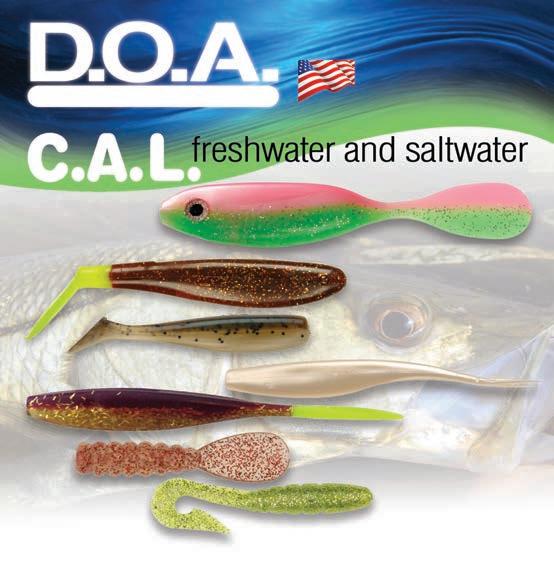

Captain Wayne Davis has been fishing the Lower Laguna-Port Mansfield for over 20 years. He specializes in wade fishing with lures.
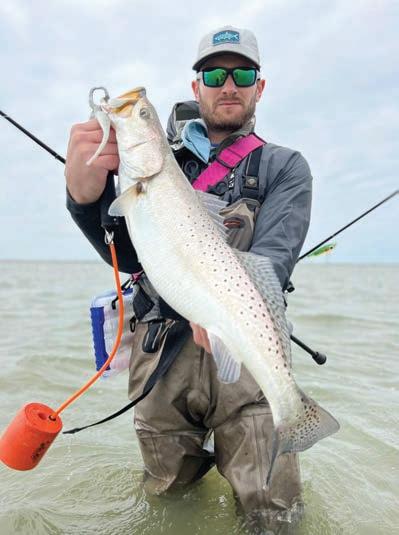
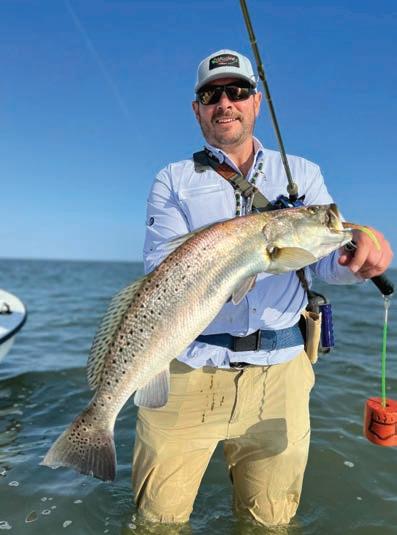

Telephone 210-287-3877 Email captwayne@kwigglers.com

Greetings from Port Mansfield! First and foremost, I want to wish everyone a Happy New Year and I’m anxious to see what 2023 has in store for us. I can honestly say I had one heck of a year in 2022; words alone cannot describe all the great people I met and the exciting things I was able to do. From fishing the Amazon to sight-casting snook here in the Laguna Madre with lures of my own design; it just doesn’t get much better. The best part is getting to do it all over again in the new year.
I want to touch on a series of events that occurred in the latter part of 2022 and how analyzing weather patterns benefitted me and could also be of benefit to you. You will likely recall that we had one heck of a sustained cold front come in just before Thanksgiving. Water temperatures dropped from 83° to 49° over seven days and it remained cold and rainy for nearly two weeks. I fished that balmy day prior to the front and we had the time of our lives. My group landed more than a hundred fish, including some over-slot trout. At the time I thought these fish looked good, and they did, but it wasn’t until the next day that I noticed something I had not recognized (in an educational perspective) from years past.
The front roared in around 9:00pm on a Friday and the air and water temperatures plummeted. We also had rain and blustery north wind that barely fell below 30mph until 10:00am the next day. We waited until 1:00pm and decided to give it a try, even with 25mph wind and temperatures still falling.
As we arrived at our destination I noticed the water temperature had fallen to 62° from the previous day’s 83°. We could feel the chill on our legs despite the layering under our waders. It didn’t take long; no bites and no active bait; we decided to make a short move. Coming off plane I noticed a few active mullet and my water temperature gauge read 64°, only two degrees warmer but active bait on the surface gave us confidence.
Within minutes we began catching a few chunky, football-shaped trout. The bite was somewhat slow and light, but frequent enough to dial into a presentation that seemed reliable. We immediately noticed the sagging bellies of the fish we were catching – some even had mullet tails protruding from their throats – yet they were still taking our lures. My brain cells started firing up and I reflected on my prior article; the fish we were catching were in a frontal-induced gorging
session, albeit probably toward the end.
The temperatures continued trickling lower and I had a trip booked three days later. The water temperature was 54° by that time and it took us almost eight hours to catch one nice trout. For the record, that bite felt like a single blade of turtle grass snagging the lure. The trout was pleasantly plump but nothing like the ones we had caught three days earlier; which got me to wondering how long a trout might go without eating after gorging as we had witnessed.
My guess is that it could depend how many days they might have lain inactive on bottom during the cold snap following the gorging session. Taking that into consideration I believe it could vary quite a bit. However, once that temperature starts to rise again, we all know they can become extremely aggressive in their feeding habits. Especially if all the right conditions fall into place – favorable amount of sun/warming, water level, lunar phase, presence of food, etc. This chain of events supports why so many anglers have such great days on warming trends during the winter months.
Sure, there are a lot of variables that can interfere and interrupt this theory, but there is also some relevancy to it. Most of us know this but, like me, sometimes it’s good to think it through and connect the dots as to the “why” factors of good fishing days. When I’m having an excellent day on the water I seldom look back a week or more to remind myself what occurred then that may have triggered an epic day. Just something to think about and hopefully learn from.
Until next time, stay safe out there and remember: Fresh is Better Than Frozen!




A Brownsville-area native, Capt. Ernest Cisneros fishes the Lower Laguna Madre from Port Mansfield to Port Isabel. Ernest specializes in wading and poled skiff adventures for snook, trout, and redfish.


Cell 956-266-6454 Website www.tightlinescharters.com

Happy New Year to everyone! In this first article of 2023 I want to start with some technical information that has helped me over the years. Every year is different; which I believe makes continuous learning one of the keys to daily success on the water.
Let’s begin with tides. I think of tidal currents as pathways for fish to travel to and from certain areas or between bodies of water. I am often asked whether I prefer high tides or low tides. My reply is any moving tide is a good thing, but I also add that some areas fish better on high tides while others are better on low tides. Now, having said that, keep in mind that a low tide tends to draw fish from the farthest reaches of marshes and back lakes and, if you know their primary escape or exit routes (around points, along sandbars and ledges, bayous, and deeper cuts), you can enjoy a great day of catching. This technique also works well in reverse on an incoming tide. In addition to gamefish, remember that tides also move the forage species they depend on. As a result, fish are more likely to feed when food is readily available in moving water, making them easier to catch when you position yourself in the middle of it.
So, what creates tides? The gravitational pull of the sun and the moon play significant roles. Studying the tide charts in this magazine and other sources can be very helpful. If you are curious to learn more about the science behind fishing success, make sure the information you gather is for the area you fish.
Redfish action has remained steady. Despite the arrival of several cold fronts and water temps dropping to the mid-60s, the majority of our redfish continue to hold in what I call shallow patterns. Potholes on grassy
flats have been good areas to target. I expect this will change soon and they will begin to stage in deeper water as fronts continue to arrive. When this happens they will likely be reluctant to feed for a few days as high atmospheric pressure dominates the weather pattern. Tricking them to take a lure will require lots of patience and slow presentations along bottom. Feeding activity will usually resume and the bite will improve the second day following the front, as temperatures rise, atmospheric pressure declines, and tides begin to return to normal.
Trout are less tolerant of cold weather and water temperatures, so their movements on and off shallow flats tends to be more frequent than redfish. However, the same as redfish, trout can be found lying in potholes on relatively shallow, grassy flats during warm days between fronts. Four-inch soft plastics rigged in weedless fashion, worked along grassy edges of larger potholes and across smaller ones is an excellent method for targeting larger trout. Natural lure colors tend to work better than brighter colors. I’m sure you have heard the old “match the hatch” theory. Well, it works down here in the Lower Laguna, especially in winter, and many trophy fish have been fooled over the years.
From what I have seen lately, our winter trout season looks promising and I expect to see many anglers scoring their personal best in the months ahead. It’s been almost two years since the devastating freeze of February 2021, and the surviving twenty-plus-inchers have had two years to continue growing. This along with many anglers adopting the CPR attitude gives me hope for a notable year.

Our snook fishery continues to thrive and anglers working the deeper ledges along the Brownsville Ship Channel have been enjoying notable catches. Look for snook to move onto shallow flats adjacent to the channel during prolonged warming periods.
In closing, I would like to return and add to the technical side of this article. A yearly event for me is referencing my calendar and noting moon phases, tide charts, and solunar feeding periods. Years of study has proven that all these factors together influence fish behavior in many ways, with my main concern being when and where to predict reliable feeding activity. Predict is a key word here; we can never achieve 100% accuracy, but you can certainly gain greater knowledge and understanding of patterns that will allow you to become a better and more successful angler, and that’s all that really matters. I hope this year brings you lots of tight lines.


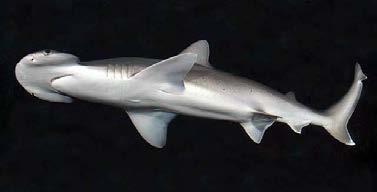
Great whites, makos, blue sharks—these are a handful of the shark species that migrate thousands of miles each year, but scientists have struggled to figure out how these sharks know how to get where they’re going. A study with more than a dozen juvenile bonnethead sharks has finally offered some answers. Sharks, like sea turtles, appear to use the Earth’s magnetic field to navigate the seas.


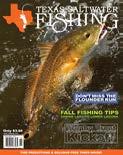


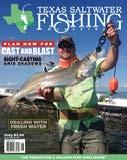
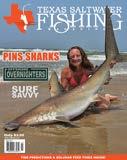


large sharks are so difficult to study in the open ocean, scientists from the Save Our Seas Foundation and Florida State University decided to conduct a controlled experiment with 20 young bonnetheads that the researchers had caught in the wild. Bonnetheads visit the same estuaries each year, so they had already demonstrated the ability to repeatedly navigate to and from a precise place. Scientists already knew that sharks are sensitive to electromagnetic fields. So, the researchers noted the swimming habits of these young sharks and then adjusted the magnetic conditions around them to match the magnetic “signature” of locations hundreds of miles away from where the sharks had been caught. If the sharks didn’t alter their swimming direction or behavior after the change, then they weren’t relying on the magnetic field to guide them. But if the sharks reoriented themselves in the direction that would be “home” in the adjusted magnetic field, that would reveal their ability to navigate based on electromagnetic signals.
The sharks didn’t swim in any particular direction when the magnetic field matched where they’d been caught, but they did head toward “home” when the magnetic field matched a distant location. The results confirmed that sharks may rely on magnetic fields to make their way thousands of miles across the ocean to the exact waters they visit year after year.

Trinity Bay - East Bay - Galveston Bay | James Plaag
Silver King Adventures - silverkingadventures.com - 409.935.7242
January is a great month to fish in parts of Lower Galveston and West Galveston bays, James says. “We do better fishing out of the boat than we do by wading, most years, in January, but it depends on the weather. The old-school drill of drifting around off Mecom’s and Green’s cuts is still productive, in some years. When doing that, we throw soft plastics on medium-light jigheads much of the time, also 52M MirrOlures. Pointing the tip of the rod at the water and pulsing it while reeling the lure in works great with the 52Ms. We usually key on areas where the water has some color to it; the clear water is normally not productive. If the weather is warm for several days, and the tides come gushing in during the afternoon hours, the bite on the reefs and in the coves on the south shoreline can be excellent for people who are willing to get out of the boat and wade. On the reefs, hard baits like Catch 5s and Catch 2000s work well, as do the soft plastics. In the coves, when there’s lots of bait jumping, topwaters will often produce bites from the big trout.”
Jimmy West - Bolivar Guide Service - 409.996.3054
Jim splits time between hunting and fishing during the first month on the calendar. “I’ll be hunting ducks most weekends, fishing more during the weeks. I’ve also got some hog hunts to run this month. The fishing has been good lately. Once the water temperatures dropped down around 50° and a little lower, we found the fish stacked up in the deeper holes in the bayous. We caught ‘em real good in there while it was still cold. Now that it’s warmed back up, the fish are shallow, and they’re concentrated where the water’s salty in East Bay. We had another six or seven inches of rain, so the portions of the bay close to where the runoff comes in are still a bit fresh. These patterns will continue through the winter. When it’s cold, the fish will move deep, and catching them will mostly require fishing out of the boat with soft plastics. During the warm spells, wading can get really good, and you can catch fish however you want to some of the time. So, it’s a good month to be outdoors in and around East Bay. Fishing is really good, if you’re after numbers of trout and reds.”
Randall Groves - Groves Guide Service
979.849.7019 - 979.864.9323
Randall says the fishing can be quite productive, even magical, in January, but conditions and priorities dictate which strategies will be most effective. “With the frequent northwest winds, the tides are often quite low in the first full month of winter. If water temperatures are cold and tides low, the fish will retreat to deeper holes. When the tide comes back to a normal level and temperatures warm up, the fish are often stacked up in water around four or five-feet deep, with rafts of mullet. I throw Norton Sand Eels on three-eighths ounce heads most of the time in this situation, colors like red magic, chicken on a chain and trick or treat. Folks who want to target the trout of a lifetime, and who aren’t bothered by fishing hard for just a few bites, should wade on the warmer days this month. My favorite lure for targeting the big trout is a Fat Boy. I like bright colors, like bubble gum pink, if the water’s murky, and more natural colors like bone diamond if the water’s clear. The most important keys when wading and targeting a trophy trout are being persistent and paying attention to the mullet around you.”
Charlie Paradoski – 713.725.2401
Charlie mentions four distinct options with good potential for folks headed to Matagorda in January. “If you’re looking to catch a big trout, January is one of the top months. Most of the big trout we catch come out of East Bay, and most are caught by people who are willing to wade. Both shorelines offer good potential, the south shoreline when it’s warmer and tides are higher, the north side when it’s colder and tides fall out. Lower tides and colder water also elevate the potential for catching big trout drifting in East Bay. Most of the fish we’re catching lately out of the boat are biting in the west end of the bay. Wading the south shoreline of West Bay is another good idea this month, if you’re wanting to catch redfish. The reds stack up in the drains and holes over there when the tides fall out to low levels. And, as we speak, the water in the Colorado River is getting saltier by the minute. So, we should be able to catch plenty of trout and reds in the protected waters of the river throughout January, if we don’t get too many more big rains.”
Palacios | Capt. Aaron Wollam www.palaciosguideservice.com - 979.240.8204 So far, the fishing in the Palacios area has been excellent since the weather cooled down. The local rivers have been producing good numbers of trout in the cooler waters. The Colorado, Tres Palacios and Lavaca rivers have all been holding solid keepers ranging up to about twenty inches. We’re catching them best on DSL lures in purple rain and magic grass rigged on three-eighths ounce heads. We’re also catching excellent numbers of fifteen and sixteen-inch trout while fishing these areas, which bodes well for next year. Wading some of the area shorelines has produced decent numbers of trout in the three to five-pound class. They’re biting Fat Boys in pear/chartreuse and pearl/black best. Redfish have been plentiful in the back-lakes. They’re gorging on grass shrimp and small crabs. We’ve been throwing pearl/ chartreuse Norton Bull Minnows and bone Spook Juniors to catch them. Night-fishing on the local piers continues to produce some good catches, with lots of eating-sized sand trout coming to hand, with the occasional keeper spec mixed in. At Pavilion Pier, locals are catching excellent numbers of bull reds and big black drum, soaking crabs and mullet. While water temperatures remain cool, the rivers and deep holes will produce best.
361.935.6833
Lynn expects to be targeting the biggest trout in the Port O’Connor area when he’s fishing in January. “We normally catch some of our biggest trout of the year this month. Most of the time, we focus on areas with a muddy bottom and either some dark grass beds or some scattered shell. We like to fish pretty shallow, but in places where deep water isn’t far away. And, we favor the afternoon hours. Most of the big trout are more active after the sun heats up the water on the flats this time of year, so we normally don’t even leave the dock until about ten or eleven o’clock in the morning, then fish through the afternoon hours. Our favorite lures this time of year are slow-sinking twitch-baits like Paul Brown Lures. We also throw Soft-Dine XLs quite a bit. With all of those, the key is to work them in at a slow pace, using the rod tip to get the heads of the lures wobbling from side to side. On
the best days, the bite on topwaters is great, but those days don’t come as often in the middle of winter as they do in other seasons.”
Rockport | Blake Muirhead
Gator Trout Guide Service - 361.790.5203 or 361.441.3894

January is a great time for Blake, as his cast and blast season reaches a crescendo. “We spend lots of days hunting ducks, then fishing our way out of the marshes this time of year. There’s some good dove hunting in the afternoons, too. On the fishing front, we usually have plenty of reds and some bigger than average trout in water about thigh-deep in some of the back-lakes. Fishing is pretty good on shorelines with a sandy, grassy bottom in most of the area bays, too. We throw soft plastics a lot this time of year. I use my old standby Norton Sand Eels in dark colors with chartreuse tails, like I do all year, but I throw the pearl/chartreuse Gulp! lures more this time of year. They work better on some of the days when the bite is not really vigorous. On the other hand, I also have some really good sessions with small topwaters during January. I like the Baby Skitter Walks, in colors like gold/ chartreuse and gold/blue. When the weather is warm and the bait is active, we normally have several days this month when we can catch plenty of reds and some of the bigger trout on those little plugs.”
Upper Laguna Madre - Baffin Bay - Land Cut
Robert Zapata – rz1528@grandecom.net - 361.563.1160
With so many deer hunters out in the brush country hunting big South Texas bucks before the season ends, the waters of the Upper Laguna Madre and Baffin Bay will be quiet during the first month of the year. That satisfies folks like me, who prefer chasing a monster trout over a monster buck. The water temperatures will decline after the passage of cold fronts, and the trout and reds will retreat to deeper water when this happens. When the sun warms up the shallows a day or two after a cold front passes, the bait and trout will move into shallower water. Soft plastics produce best in the middle of winter. I like to rig lures like the four-inch Bass Assassin Sea Shads in colors like plum/chartreuse, chicken on a chain and salt&pepper/chartreuse on eighth-ounce Spring-lock jigheads when targeting trout in January. We do best while wading, so wise anglers will check their waders for leaks before each outing and wear ForEverLast Ray Guards at all times. When warm weather persists, and the sun shines for three or four days straight, fishing for both black and red drum in ultra-shallow water with shrimp and Fish-bites rigged on eighth-ounce jigheads will be productive.
Fishing in the ULM and Baffin Bay area is simple in some ways, during January. “We usually have plenty of trout and redfish in the Intracoastal Waterway and adjacent channels this time of year. When targeting trout and reds in those places, with cold water temperatures, it’s really important to pay attention to the size of the jighead rigged with the soft plastics. Depending on the strength of the currents and the winds, the size of the jighead determines how easy it is to keep the lure in close contact with the bottom. In general, a slower fall rate makes the fish more likely to strike in cold water, so using the lightest jighead which keeps the lure close to the bottom is optimal. Most of the time, the fish hang out close to the main drop-offs, or on the ledges extending out from them. We also catch lots of trout and reds this time of year casting at the deepest edges of the grass beds at the outer edges of the flats adjacent to Beacroft’s and Emmord’s holes. Tossing around rocks close to deep water next to the ledges on the Kenedy shoreline also works well.”
P.I.N.S. Fishing Forecast | Eric Ozolins 361-877-3583 | Oceanepics.com

January and February bring the coldest water temperatures of the year.
On ultra-cold days, action can seem dormant, but on sunny days, the action picks up. The Florida pompano run started strong this year. For the remainder of winter, any warm day with green water close to the beach should provide ample opportunity to catch good numbers of pompano. They bite best on shrimp or Fish-bites rigged on small 2/0-4/0 circle hooks. Bright colors attract their attention. Calm conditions can create the potential for catching monster surf specks this time of year. Slow-sinking twitch baits worked slowly produce best. Redfish of all sizes will also be present in the surf. Mullet is the best bait for them, but cut whiting also works well. The mullet must be less than 12 inches in length to be used legally, up to February 1st. January can provide a bounty of black drum. Winter sharks will also be around, including sandbar sharks, which can measure more than seven feet in length. The smaller Atlantic sharpnose and bonnetheads will be more numerous. Water temperatures at or above 60° increases the opportunity for catching sharks. Cooler water usually forces them out deeper.
Port Mansfield | Ruben Garza
Snookdudecharters.com – 832.385.1431
Getaway Adventures Lodge – 956.944.4000
During this month of rapidly changing weather patterns, the smartest anglers key on any and all signs which indicate the presence of fish, whether jumping mullet or other small forage species flipping around at the surface. Diving pelicans can also lead observant anglers to schools of fish. West Bay is a great place to try. Its middle section makes for good wading on lower tides. The area behind the cabins in The Saucer can also be productive in January. In both these places, topwaters and soft plastics produce well at times. Up north, the east side of Dubb’s Island is a great area to look for trout. Water ranging from thigh to chest-deep over grass and potholes in that area holds plenty of solid keeper trout and the occasional trophy fish. A bit farther north, on the west shoreline, the stretch around the mouth of Little Bay can be quite productive, for both waders and drifters. During the middle of winter, tides usually run quite low, so some areas become inaccessible. Wise captains remember this and don’t run into areas where really shallow water proves unforgiving and can leave people stranded and walking toward deeper water looking for help.
Lower Laguna Madre - South Padre - Port Isabel Aaron Cisneros | tightlinescharters.com – 956-639-1941
With winter approaching soon, we’ve seen the patterns which produce the best catching change. Most of our best fishing over recent weeks has happened in the afternoon hours, stretching into the evenings and the early hours of the night, when water temperatures reach their highest levels. Our trout fishing has been steady. We’re finding most of our fish in three to four feet of water, feeding over sandy potholes breaking up a grassy bottom lying closer to deeper water. KWiggler Mansfield Margarita Ball Tails rigged on eighth-ounce screw-lock jigheads have been earning plenty of strikes. We’re catching even better numbers of redfish than trout. Calm, warm mornings create great conditions for finding the reds feeding in water ranging from a foot to two-feet deep, over a sandy bottom. The smaller topwaters like Spook Juniors and She Pups work well at times in these conditions, but KWiggler Ball Tails in plum/chartreuse rigged on eighth-ounce screw-lock heads have produced bites more consistently. During these colder months, the smart anglers prepare accordingly, wearing the proper types of clothing and timing their outings to coincide with the best potential for catching, usually meaning fishing some kind of tidal movement or lunar bite during the afternoon hours.

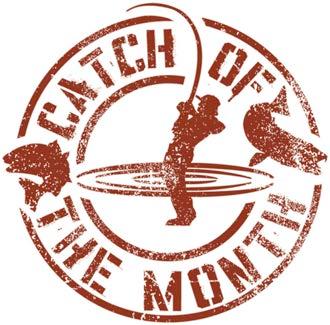
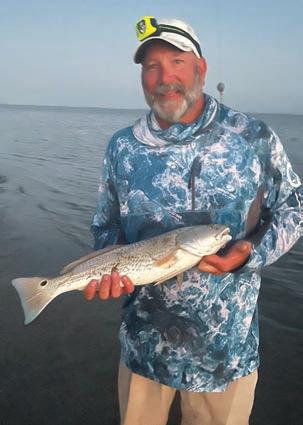
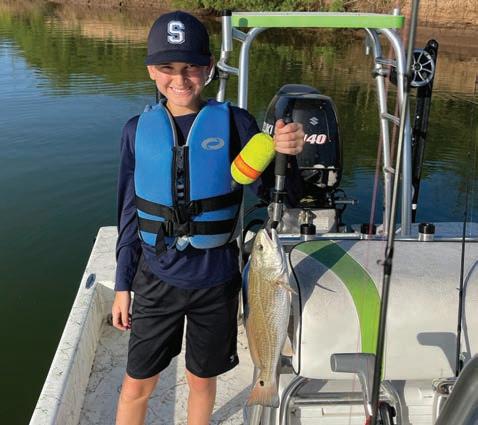
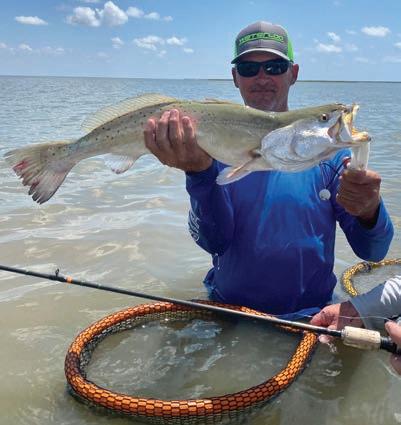
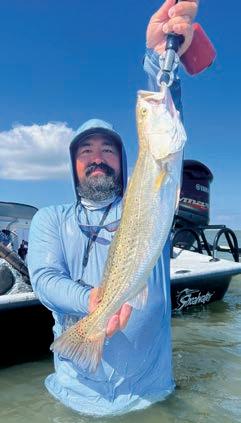
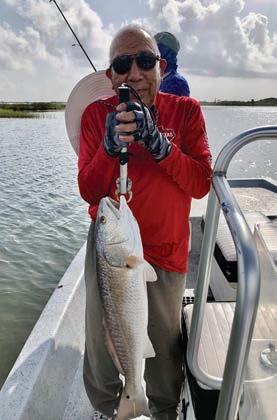
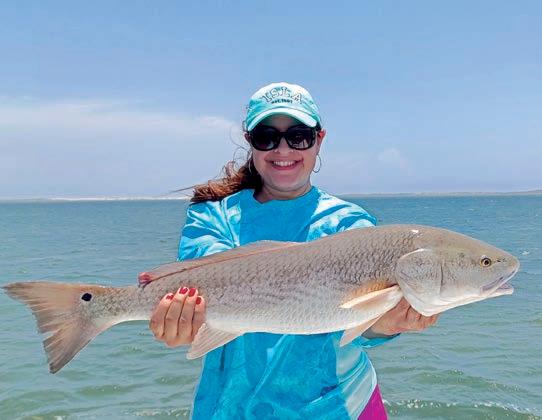
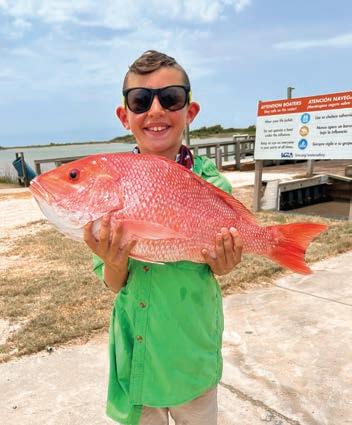
 Baron Carreon Colorado River - 21” redfish
John Vann
Galveston Bay - 24” trout CPR
Dalinda Ramirez Maza Lower Laguna Madre - 33” redfish
Mike Vasquez Estes Flats - 31” redfish
Mike Gartner Galveston Bay - 23” redfish
Rusty Evelo Matagorda Bay - 28” trout
Baron Carreon Colorado River - 21” redfish
John Vann
Galveston Bay - 24” trout CPR
Dalinda Ramirez Maza Lower Laguna Madre - 33” redfish
Mike Vasquez Estes Flats - 31” redfish
Mike Gartner Galveston Bay - 23” redfish
Rusty Evelo Matagorda Bay - 28” trout

First come – first published! Photos are judged on artistic merit and sporting ethic displayed. No stringer, cleaning table, or hanging board images allowed. Digital images only. Adjust camera to high or best quality. All images become property of TSFMag.
Email to: Photos@TSFMag.com
Include short description of your catch with name, date, bay system, etc.
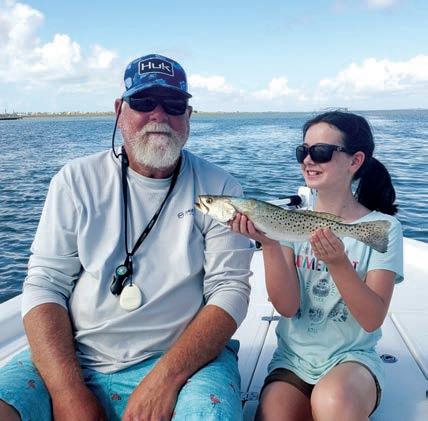

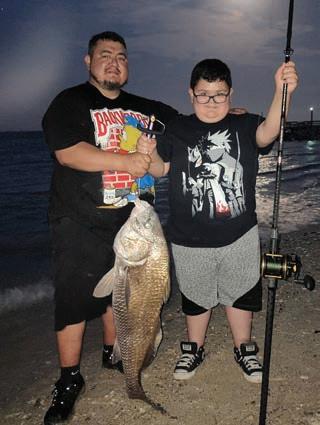
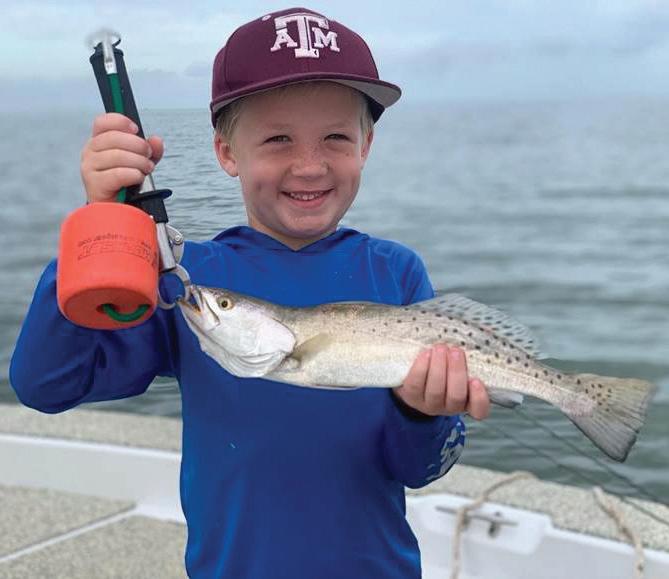
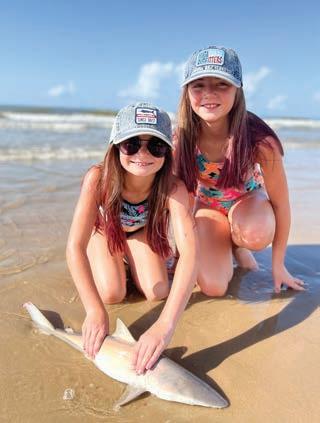


 Kailani LeFevre Palacios - 20” first trout!
Rainey Watson
East Galveston Bay - first solo trout!
Analeigh & Emma Turner Matagorda Beach - black tip shark
Katherine Dugan Laguna Madre - 18” trout
Jack Dugan Packery Channel - 17” redfish
Johnny & Jordan Rodriguez Magnolia Beach - 35” black drum CPR
Julia Dugan with John Jacobs Laguna Madre - first trout!
Kailani LeFevre Palacios - 20” first trout!
Rainey Watson
East Galveston Bay - first solo trout!
Analeigh & Emma Turner Matagorda Beach - black tip shark
Katherine Dugan Laguna Madre - 18” trout
Jack Dugan Packery Channel - 17” redfish
Johnny & Jordan Rodriguez Magnolia Beach - 35” black drum CPR
Julia Dugan with John Jacobs Laguna Madre - first trout!
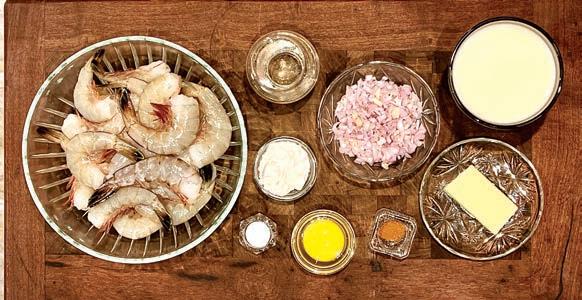

Special thanks to Donna Boyd for sharing this recipe, originally published in the Friedens Church of Christ Cookbook, dated 1977. The cookbook credits Violet Janac as the contributor and we have thus far been unable to contact her. We would be very grateful should any of our readers be able to assist us in that effort. We found Violet’s recipe to be another very delicious way to enjoy shrimp and hope you will too. -Pam Johnson
pan and sauté shallots until tender. Blend in flour
cook slowly 3 to 5 minutes more, stirring constantly. Stir in

until smooth. Add salt, pepper, and wine. Cook about 10 minutes more. Remove from heat, add shrimp, and quickly stir in egg yolk. Return to heat and continue cooking slowly until heated through. Place in ramekins and sprinkle tops with paprika and heat under broiler until piping hot. Yields – 3-4 Servings
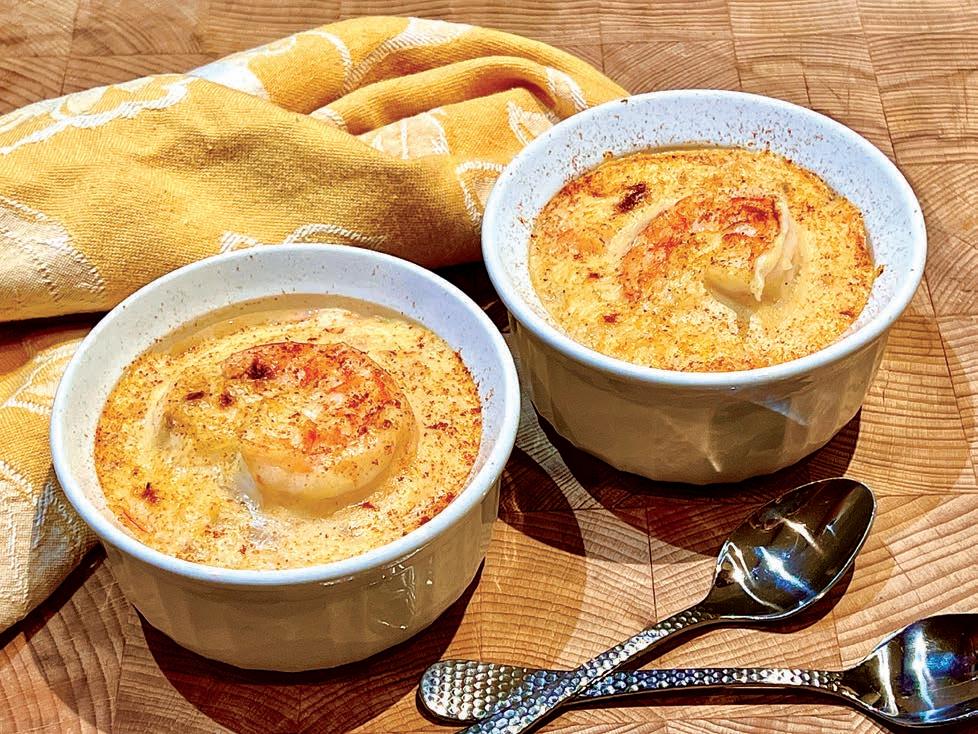




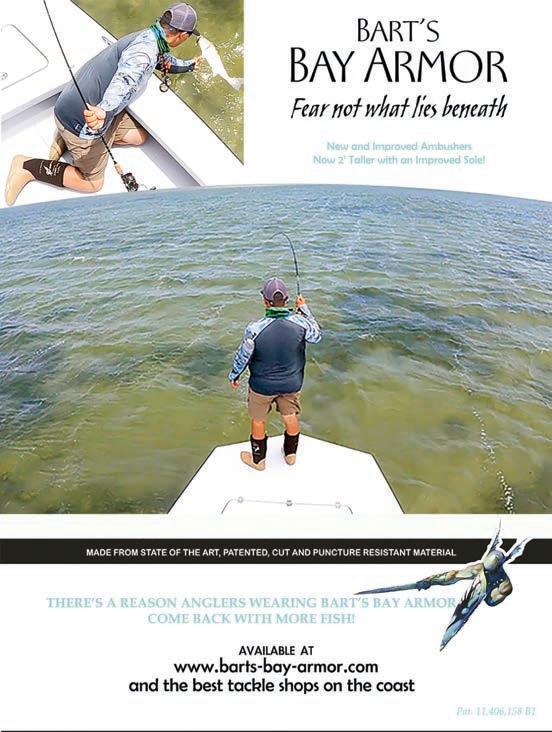
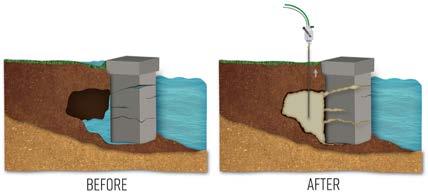




Chris Mapp, owner of Coastal Bend Marine and Flats Cat Boat Company. Great Service, Parts & Sales. “What can we do for you?”
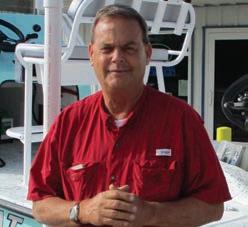
Boat trailers have come a long way. What started off with round axles, and more recently galvanized square tubing, to resist the corrosive effects of salt water. Springs have always been made of spring steel that could not be galvanized because the springs would crystallize, making them brittle as glass. Springs are now mostly a thing of the past, frames are primarily aluminum alloy, and the fastener hardware is stainless steel. The hubs are galvanized and the lights are now LED. Wheel bearings last longer due to upgraded technology, including better lubricants and seals with the ability to keep out saltwater. A muchupgraded package all the way around.
Torsion axles are now the most common suspension system under boat trailers and they are virtually maintenance free…to a point. While torsion axles may not need new springs, they do have a life expectancy in salt water, normally seven to eight years. The middle section of the torsion axle tubing has a slight dip that will hold saltwater, which eventually eats through the galvanization and weakens
the axle. Washing the boat and trailer will usually not get to this area unless the owner puts forth a specific effort.
Another little known aspect of torsion suspension is that the trailer may begin to sag under load as the rubber inserts that anchor the torsion arm to the axle tube deteriorate over time, allowing the tire to rub the undersurface of the fender. Removing the wheel is an easy way to perform a visual inspection and avoid tire failure on the highway.

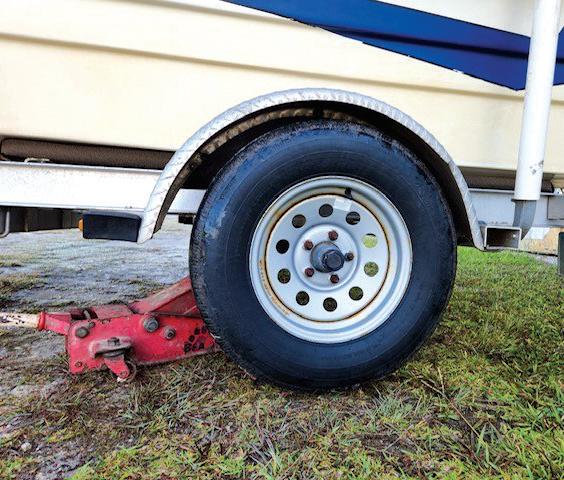
Have a great winter season!

Coastal Bend Marine – Port O’Connor, TX coastalbendmarine.com – 361-983-4841
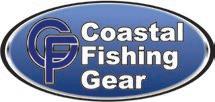

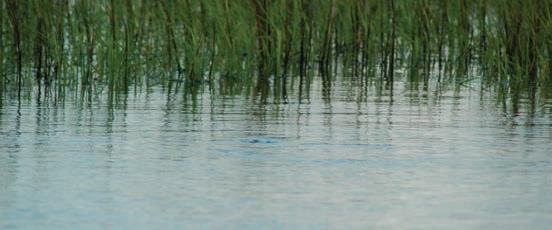



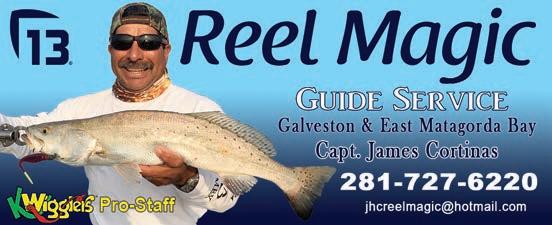


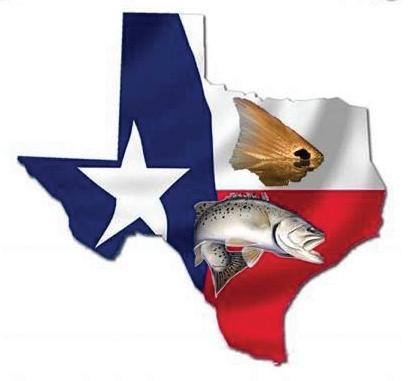






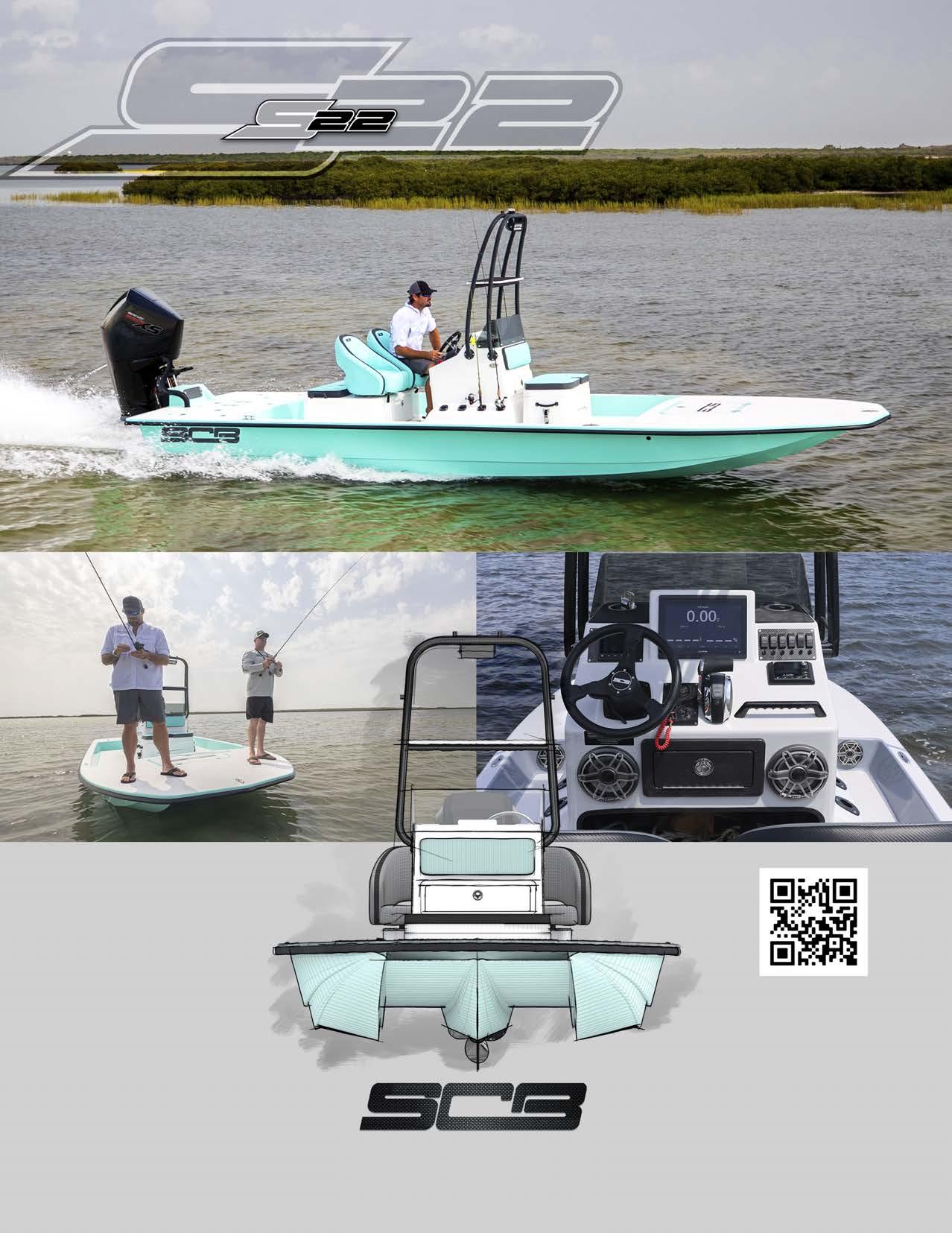

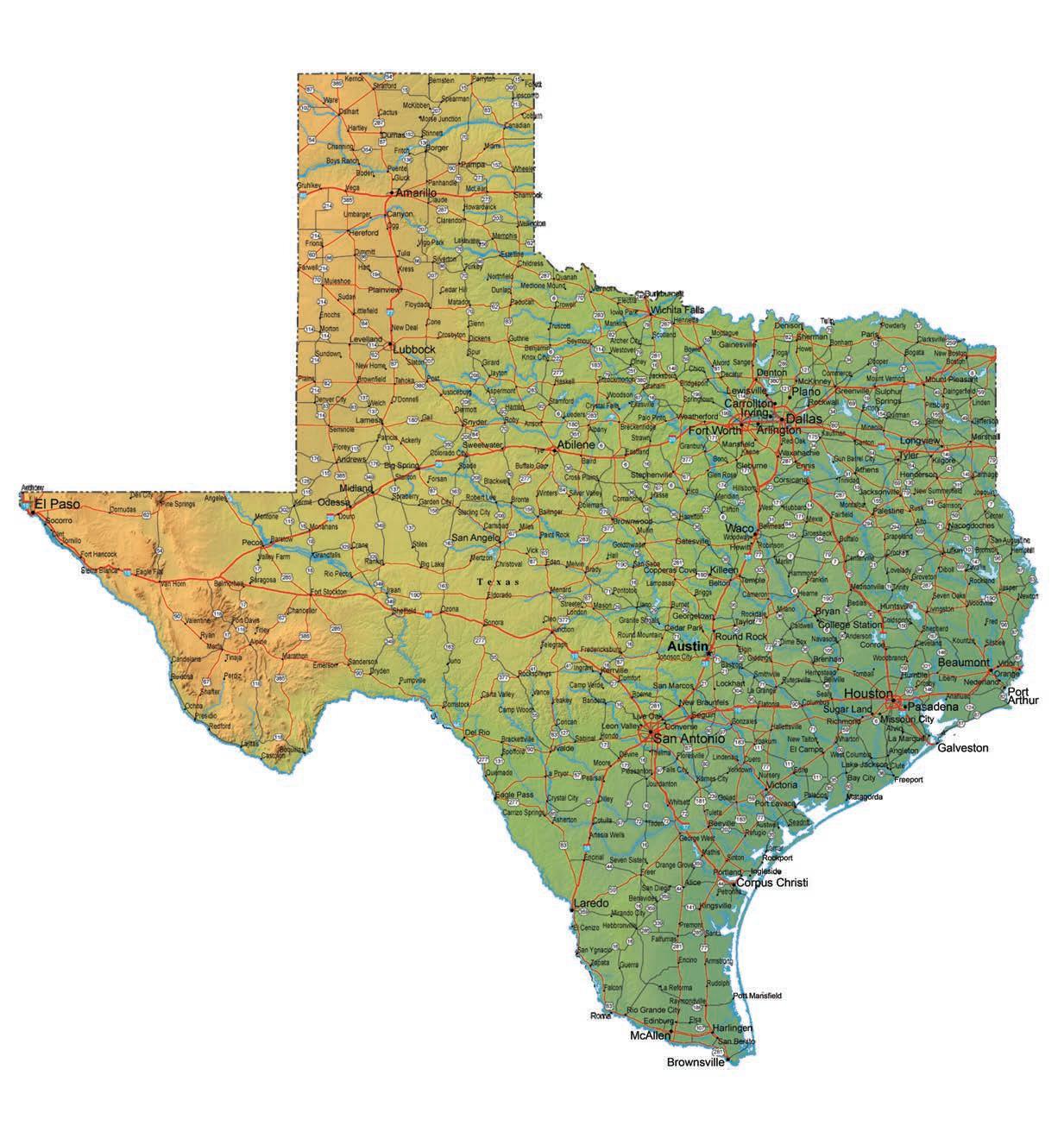


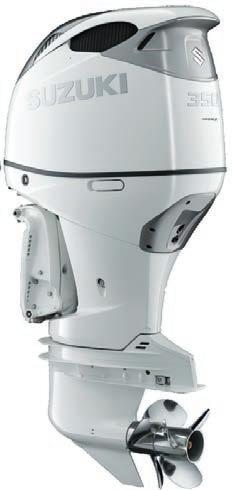

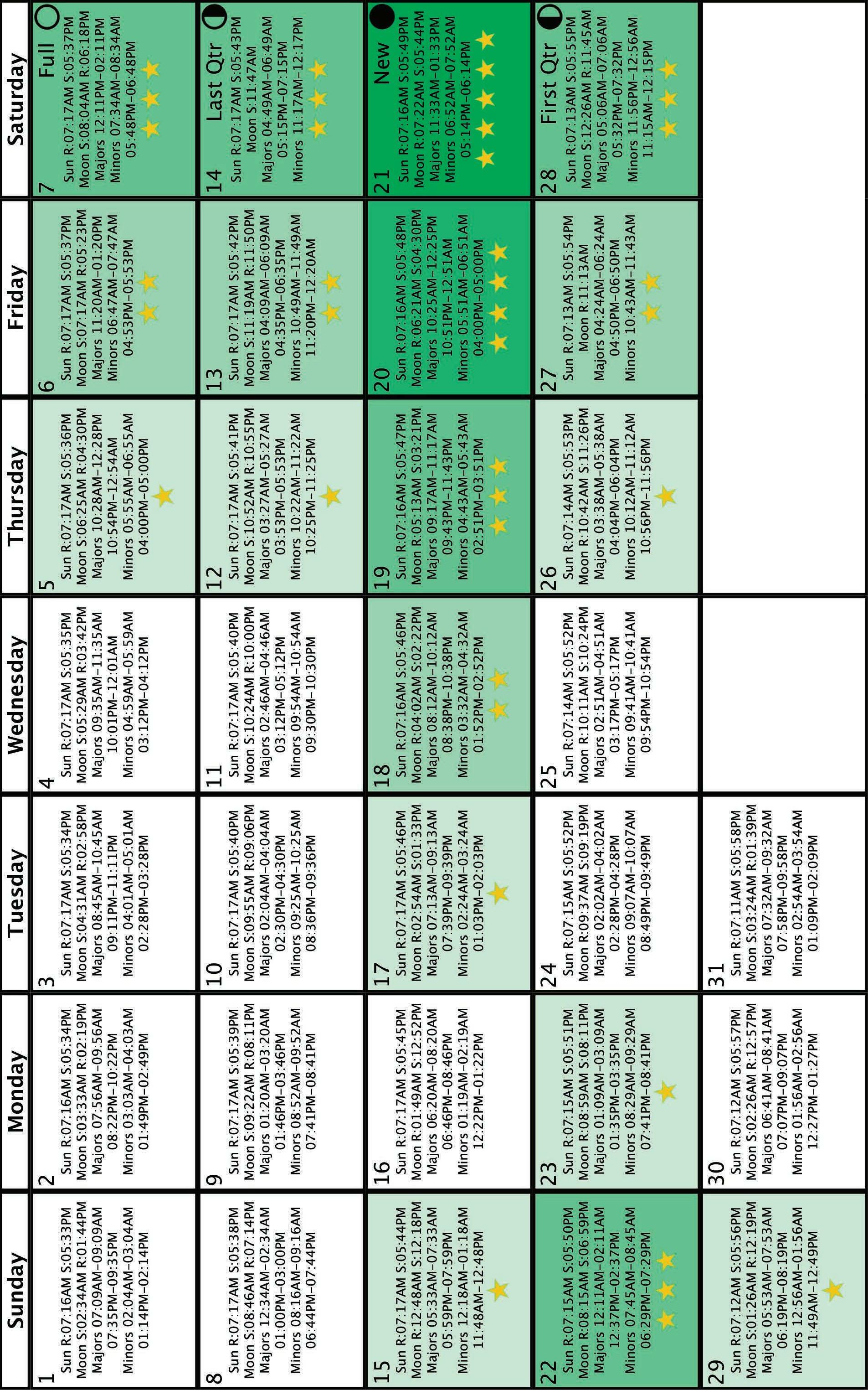 Brought to you by
Brought to you by





